Ed Friedlander, M.D., Pathologist
scalpel_blade@yahoo.com


Cyberfriends: The help you're looking for is probably here.
Welcome to Ed's Pathology Notes, placed here originally for the convenience of medical students at my school. You need to check the accuracy of any information, from any source, against other credible sources. I cannot diagnose or treat over the web, I cannot comment on the health care you have already received, and these notes cannot substitute for your own doctor's care. I am good at helping people find resources and answers. If you need me, send me an E-mail at scalpel_blade@yahoo.com Your confidentiality is completely respected.
 DoctorGeorge.com is a larger, full-time service.
There is also a fee site at myphysicians.com,
and another at www.afraidtoask.com.
DoctorGeorge.com is a larger, full-time service.
There is also a fee site at myphysicians.com,
and another at www.afraidtoask.com.
Translate this page automatically
 |
With one of four large boxes of "Pathguy" replies. |
 I'm still doing my best to answer
everybody.
Sometimes I get backlogged,
sometimes my E-mail crashes, and sometimes my
literature search software crashes. If you've not heard
from me in a week, post me again. I send my most
challenging questions to the medical student pathology
interest group, minus the name, but with your E-mail
where you can receive a reply.
I'm still doing my best to answer
everybody.
Sometimes I get backlogged,
sometimes my E-mail crashes, and sometimes my
literature search software crashes. If you've not heard
from me in a week, post me again. I send my most
challenging questions to the medical student pathology
interest group, minus the name, but with your E-mail
where you can receive a reply.
Numbers in {curly braces} are from the magnificent Slice of Life videodisk. No medical student should be without access to this wonderful resource. Someday you may be able to access these pictures directly from this page.
Also:
Medmark Pathology -- massive listing of pathology sites
Freely have you received, freely give. -- Matthew 10:8. My
site receives an enormous amount of traffic, and I'm
handling about 200 requests for information weekly, all
as a public service.
Pathology's modern founder,
Rudolf
Virchow M.D., left a legacy
of realism and social conscience for the discipline. I am
a mainstream Christian, a man of science, and a proponent of
common sense and common kindness. I am an outspoken enemy
of all the make-believe and bunk which interfere with
peoples' health, reasonable freedom, and happiness. I
talk and write straight, and without apology.
Throughout these notes, I am speaking only
for myself, and not for any employer, organization,
or associate.
Special thanks to my friend and colleague,
Charles Wheeler M.D.,
pathologist and former Kansas City mayor. Thanks also
to the real Patch
Adams M.D., who wrote me encouragement when we were both
beginning our unusual medical careers.
If you're a private individual who's
enjoyed this site, and want to say, "Thank you, Ed!", then
what I'd like best is a contribution to the Episcopalian home for
abandoned, neglected, and abused kids in Nevada:
My home page
Especially if you're looking for
information on a disease with a name
that you know, here are a couple of
great places for you to go right now
and use Medline, which will
allow you to find every relevant
current scientific publication.
You owe it to yourself to learn to
use this invaluable internet resource.
Not only will you find some information
immediately, but you'll have references
to journal articles which you can obtain
by interlibrary loan, plus the names of
the world's foremost experts and their
institutions.
Alternative (complementary) medicine has made real progress since my
generally-unfavorable 1983 review linked below. If you are
interested in complementary medicine, then I would urge you
to visit my new
Alternative Medicine page.
If you are looking for something on complementary
medicine, please go first to
the American
Association of Naturopathic Physicians.
And for your enjoyment... here are some of my old pathology
exams
for medical school undergraduates.
I cannot examine every claim which my correspondents
share with me. Sometimes the independent thinkers
prove to be correct, and paradigms shift as a result.
You also know that extraordinary claims require
extraordinary evidence. When a discovery proves to
square with the observable world, scientists make
reputations by confirming it, and corporations
are soon making profits from it. When a
decades-old claim by a "persecuted genius"
finds no acceptance from mainstream science,
it probably failed some basic experimental tests designed
to eliminate self-deception. If you ask me about
something like this, I will simply invite you to
do some tests yourself, perhaps as a high-school
science project. Who knows? Perhaps
it'll be you who makes the next great discovery!
Our world is full of people who have found peace, fulfillment, and friendship
by suspending their own reasoning and
simply accepting a single authority which seems wise and good.
I've learned that they leave the movements when, and only when, they
discover they have been maliciously deceived.
In the meantime, nothing that I can say or do will
convince such people that I am a decent human being. I no longer
answer my crank mail.
This site is my hobby, and I presently have no sponsor.
This page was last updated February 6, 2006.
During the ten years my site has been online, it's proved to be
one of the most popular of all internet sites for undergraduate
physician and allied-health education. It is so well-known
that I'm not worried about borrowers.
I never refuse requests from colleagues for permission to
adapt or duplicate it for their own courses... and many do.
So, fellow-teachers,
help yourselves. Don't sell it for a profit, don't use it for a bad purpose,
and at some time in your course, mention me as author and KCUMB as my institution. Drop me a note about
your successes. And special
thanks to everyone who's helped and encouraged me, and especially the
people at KCUMB
for making it possible, and my teaching assistants over the years.
Whatever you're looking for on the web, I hope you find it,
here or elsewhere. Health and friendship!
We have fed the heart on fantasies,
From violence, battle, and murder, and from dying suddenly and unprepared, Good Lord deliver us.
Anybody can kill anybody. Razors pain you / Rivers are damp /
Go not in and out at the courts of law, that thy name may not stink.
How many Americans does it take to screw in a light bulb? Confucius said, "In hearing litigation, I am no different from any other judge. But if you insist on a
difference, it is, perhaps, that I try to get the parties not to resort to litigation in the first place."
The higher you go, the crookeder it gets. I assume that is your accomplice in the wood chipper?
People will never stop committing atrocities until they
stop believing absurdities.
Did you hear about the hippie who mixed LSD and prune juice?
Physical injury (all)
OBJECTIVES
Describe how the medical examiner's office operates, what deaths
must usually be referred there, and how bodies may be identified.
Properly complete a death certificate, avoiding the usual pitfalls.
Distinguish the various manners and mechanisms of death.
Tell how a rural primary care physician called to a crime scene
can estimate the time of death.
Describe the most common findings in physical child abuse,
and mention the various medical conditions which may simulate it.
Distinguish predictable and unpredictable medication side effects.
Give the anatomic pathology seen with the common serious drug side-effects.
Describe the extent of the illegal drug problem in the US. Recognize
needle marks, and describe the internal anatomic pathology and pathophysiology
of injectable drug abuse. Give the "two principles" rule for all drug testing
that will have medicolegal implications.
Suspect poisoning by thallium, arsenic, mercury, and lead when appropriate. Describe
their pathophysiology and distinctive anatomic lesions as applicable.
Describe the anatomic pathology and pathophysiology of cocaine use. Give an
account of death through excited delirium.
Give a short account of the physiology and health effects of absinthe, cannabis,
and the recreational inhalants.
Describe the anatomic pathology and pathophysiology, as applicable,
of poisoning by paraquat, organophosphates, and dioxin.
Describe what we know about the health consequences of caffeine use.
Give a full account of what we know about the pathophysiology and anatomic
pathology of acute and chronic alcohol abuse, including the quantitative aspects.
Describe what happens to people who ingest methanol, isopropanol, and ethylene glycol.
Distinguish abrasions, contusions,
lacerations, and the various kinds of incised wounds.
Given a weapon or proposed scenario, decide whether it could have produced
illustrated pathologic changes. Avoid the common pitfalls. Describe
the usual ways in which blunt trauma causes death.
Distinguish suffocation, smothering, strangulation, mechanical asphyxia,
and choking.
Describe the common scenarios, and how you would use pathology to confirm or
discredit a scenario. Explain what happens during hanging.
Give accounts of the common chemical asphyxiants. Especially,
describe what you would
see in illness and death due to carbon monoxide toxicity.
Describe injuries from extreme heat, and how various kinds of burns
do their damage.
Describe the pathology of drowning.
Explain how pathologists deal with drowning cases.
Give a full account of the pathology of blast, decompression, and
electrical injuries. Describe how death occurs, and what the pathologist
might see, in heat stroke, heat exhaustion, and hypothermia.
Explain how a physician might help evaluate the claim of someone seeking
asylum and claiming to have been tortured.
Explain how ionizing radiation injures living tissue. Know the various definitions for
quantitating radiation
and its effects on people. Give the pathology of radiation sickness of varying
degrees of severity.
Discuss briefly how the nature and impact
of war have changed since the beginning
of the twentieth century.
Describe the usual situations which lead to homicide.
Describe the usual situations which lead to suicide.
After you've reviewed the pathology of violence,
talk with your friends about the following often-heard
claims. Reasonable people will differ about all of them.
"We are all born good. Criminals are products of their environments."
"Violence in the U.S. is largely the result of the entertainment industry."
"A physician has a duty to urge people not to keep firearms in their homes."
INTRODUCTION
{07130} violent death, don't try these at home
Nothing that pertains to human suffering and death is outside the larger domain of human
pathology. Knowing what motives underlie most homicides and suicides is as important for a
student physician as knowing which special stain helps the lab define a hemangiopericytoma.
Especially, groups of people who are hurting and confused will lash out against neighbors who are slightly (but
not too much) different from themselves. This behavior begins with "extremists", who of course can
explain to you why they are right, what past injustices they are redressing, how they are "doing
God's work", "cleansing the evil", and so forth. Soon the savvy politicians follow, and next, many
"normal" people are doing things which most will regret when
they come to their senses, if they themselves survive.
This happens around the world, and in the "developed world's" slums
and prisons.
Force, or the credible threat of force, will always govern human affairs.
The best for which we can hope is that this will be the force of good laws.
Even the great pacifists of our era (Gandhi, Martin Luther King, others) knew this.
To their credit, they were able to bring about change with as little violence
as possible, by placing their own lives on the line.
I wish this kind of personal courage from "the world's leaders" was
the norm today.
Especially since
the rise of guerilla warfare, political violence has been directed
primarily against civilians. Soldiering, once the honorable life of
a brave man, has become largely a matter of
armed thugs killing (or starving)
civilians and trying to leave no witnesses to the actual violence.
In a war zone,
the opposite sides take turns, and the soldiers (government, guerillas,
child recruits)
are often safer than the non-combatants.
There has never been a war between two genuine democracies.
When a democracy and a non-democracy
go to war, it has become the norm for the
non-democratic side
deliberately to place their own non-combatants, especially children,
in harm's way
so as to generate misguided sympathy.
People with agendas (especially the Left: J. Pub. Health. Pol. 19:
289, 1998) deluge us with claims that the United States is an
extraordinarily violent society. This ignores the fact that the violence
is concentrated in underclass communities.
These communities, for whatever reason, are lawless and ridden with
substance abuse, and
the "code of the streets" requires posturing ("keeping respect")
that ultimately invites re-injury (Am. J. Pub. Health 95: 816, 2005).
Where there is not
a culture of lawlessness, dependency,
failure and despair, and where illegal drugs are not being dealt,
people in the US are as safe as anywhere in the world (and safer than
most places). Among "indigenous peoples" and in the slums of the
poor nations, violence and murder are far more prevalent.
Despite the "noble savages" claims of the Left,
the evidence of archeology is every bit as horrorific (Sci. Am. 289(2): 33, 2003).
Nothing
else can possibly work.
If we make peaceful revolution impossible, we make violent revolution
inevitable. --Jack Kennedy
People who abuse alcohol, do drugs, choose a violent lifestyle,
and/or do tobacco consume a grossly
disproportionate amount of health care. You'll be very impressed
when you go on rotations.
DEATH INVESTIGATION AND THE PRIMARY CARE PHYSICIAN
The first problem in any examination of death is find out whose body it was. Remember that
identification of remains by distraught relatives is notoriously unreliable.
The police will almost always do fingerprinting and/or dental identification.
For skeletonized remains, the forensic anthropologist (a Ph.D. specialty
allied to pathology) can be extremely helpful.
Next, you may be asked to estimate the time of death. This is not an exact science. * Ed's time-of-death program
is now getting thanks from police and prosecutors around the world.
* A man convicted (very likely
wrongly) of a godawful rape-murder based on unreliable estimates of how fast you digest dinner:
AJFMP 12: 344, 1994. Scientific pathologists hate charlatans as much as
scientific clinicians hate health-care quacks. For bodies found in the great outdoors, maggots are the medical examiner's little friends (more than
you want to know about maggots: J. For. Sci. 38: 702, 1993).
We fat (i.e., fatten) all creatures else to fat us, and we fat ourselves for maggots.
{07024} maggots
In forensic pathology, histologic study of the tissues plays a very limited
role.
If the law does not require a medical examiner's inquest, or if you are the
medical examiner, keeping the following in mind will help you avoid the usual
pitfalls.
The cause of death is your best opinion, as a physician, with or without an autopsy. You list this on
the death certificate.
CAUSE OF DEATH: Thromboembolus in right main pulmonary artery (circa 1 minute)
SECONDARY TO: Thrombophlebitis of leg vein (circa 5 days)
SECONDARY TO: Adenocarcinoma of the pancreas (circa 6 months)
NOTE: You may call the most important (to the lawyers)
item on your list the "proximate" cause of death, i.e., what set the fatal
chain of events in motion. "Cancer of the
breast" is okay; "coronary artery atherosclerosis" probably isn't (why not?)
NOTE: Please don't write "cardiopulmonary arrest" as the cause of death. We already knew that....
The mechanism of death is your story. "The Trousseau pulmonary embolus strained the right
ventricle and a rhythm disturbance developed." Once again, this is your best opinion.
The manner of death is for the lawyers. You might list your opinion on your death certificate, too.
In the above instance...
MANNER OF DEATH: Natural
Here are your choices:
Suicide: At the very least, the person did something that resulted in his or her death, and this was
more or less what the person intended.
Accident: These deaths resulted from some kind of unplanned, unintended injury. They include
most "therapeutic misadventures" (i.e., mishaps at the doctor's or dentist's).
Notoriously, if sporotrichosis from a rose-thorn prick were to lead to death,
it would be an accidental death.
Among the grayest areas are "accidents" in the workplace due to employer negligence;
many prosecutors now consider these to be homicides (Am. J. Pub. Health 90: 535, 2000).
Natural: Death due to disease or birth defect. (NOTE: "Unnatural death" means homicide, suicide,
or accident.)
Undetermined: You're an honest doctor and you know you can't really tell. This isn't a bad category
for normal-looking, 300-year-old skeletons found in the desert, most cases of "sudden infant death
syndrome" with no proper death-scene workup, substance abusers or organic-brain-syndrome
people found at the bottom of the stairs ("did they fall or were they thrown?"),
etc., etc.
NOTE: If I wrongfully bite you, and you go to the hospital and are rightly treated with penicillin,
and you die of anaphylaxis as a result of the penicillin injection, your death is probably a homicide.
NOTE: If a guy shoots himself, and spends six months in the hospital recovering, and dies of a
pulmonary embolus from being at bed-rest for so long, it's still a suicide.
NOTE: By common practice, if a guy has bad emphysema and blows out his lung trying to inflate
his kid's balloon, it's "natural", not "accidental".
NOTE: The good medical examiner always asks "Why today rather than yesterday?"
especially when the only finding is 3-vessel coronary disease.
NOTE: "Therapeutic misadventures" are of relatively less interest nowadays in which we expect a
certain number of fatalities from powerful therapies. If someone dies of pseudomonas sepsis while
undergoing a bone marrow transplant for leukemia, death is "natural", i.e., an not-unanticipated
consequence of the illness and its treatment.
NOTE: Physician-assisted suicide will be part (though hopefully
still an infrequent part, thanks to more humane terminal care in
general) of mainstream medicine when you're in practice.
These deaths (along with today's discreet acts of euthanasia)
will be registered as natural deaths.
NOTE: If you find me dead in front of the TV, with a half-eaten greaseburger dripping on my
trouser leg, stinking of tobacco, and I have 3-vessel coronary disease and have been complaining of
angina, and you don't know something's amiss or see anything curious on examining my body
or the scene, go
ahead and sign me out as "natural; cause of death is atherosclerotic coronary artery disease". Yeah,
a few tricky homicides probably get missed.
NOTE: Although there is no need to point out the irony, deaths from oat cell carcinoma,
heroin-shooter's endocarditis, cocaine heart,
and Laennec's cirrhosis are "natural deaths".
{07135} morbid obesity, another contributor to "natural" death
MORE ABOUT DEAD BODIES
Timing...
After a near-plateau of variable duration (heat generated by anaerobic metabolism
approximately matches heat loss), the body cools at one degree celsius per hour in the
first 12 hours, then 1/2 degree celsius for however long it takes to get
to room temperature. Circumstances
(clothing, obesity, ambient temperature, mystery factors) alter this
rate of cooling tremendously.
Things happen very differently in bodies deposited in the water. There are
frequent surprises. A newborn with near-zero internal body flora, and
some other folks, may not
putrefy.
* Jack Kevorkian's original claim to fame was his attempts to
use the optic fundi to determine time of death in very early cases:
J. For. Sci. 6: 261, 1961; Am. J. Path. 32: 1253, 1956.
You are already familiar with rigor mortis (one-time stiffening of the body after death.
In addition to the conventional teaching that this is due to
depletion of ATP with subsequent binding of actin to myosin,
I suspect this is due at least in part
to the
influx of calcium through injured membranes.
You also know livor mortis (I say LYE-vorr; others say "LEE-vorr"; "lividity",
pooling of the blood; this becomes
fixed/patterned after a while, and can tell you if the body has been moved.)
* Leave the arcana of decomposition ("adipocere burns like candle wax") and the identification of
decomposed bodies to us. Again, remember
that a distraught family member's identification of a dead
body is notoriously unreliable. Check the "electrolytes" handout for more on determining electrolyte
status at the moment of death from analyzing the vitreous humor. Approach to the dismembered
body: AJFMP 12(4): 291, 1991. "Cadaveric spasm" is instantaneous rigor,
seen when death occurs with
considerable muscular exertion (gripping something, as a branch
in someone falling
down a mountain) and/or major motor
seizure and/or emotion (battlefield, torture).
{07558} livor mortis
THE MEDICAL EXAMINER'S OFFICE
The medical examiner is a physician who autopsies, or has
a pathologist autopsy,
certain dead
bodies. It is a government-appointed position.
Plenty of medical examiners are general pathologists. And in rural communities,
physicians who are not pathologists can do this work, getting consultation as needed.
By contrast, the coroner
is a government official who makes official rulings about
the natures of particular deaths. Elsewhere, the coroner may simply be a
college student whose real job is completing routine paperwork, rubber-stamping
the medical examiner's conclusions. And in others,
it may be a funeral director, or way out in the country, whoever owns
a truck and is willing to transport dead bodies. Laws involving coroners
can be interesting, and in some jurisdictions, it's also the coroner's job to
arrest the sheriff should he/she misbehave. If you, the licensed physician, are caring for someone and he or she dies of his or her disease, you fill
out the death certificate and you needn't even notify the Medical Examiner's office.
Certain deaths must be referred to the medical examiner. These include:
In a typical community, around 15% of deaths will fall under the medical examiner's jurisdiction,
and of these, maybe 35-45% will get autopsied.
Where it's an obvious, non-questionable suicide, the medical examiner
will at least attempt to obtain the bullet if there is one. I used to do more extensive
autopsies when I could, in the hopes of finding some hidden physical disease
(i.e., cancer of the pancreas, brain tumor) and if a woman, determine
whether she was pregnant. It's only an hour or two extra work for me,
and would make a lot of difference for the family.
For deaths in fires, the medical examiner will at least examine the airways.
If a driver dies after losing control of the car or bicycle,
or a swimmer is observed to go under,
I always did a complete
autopsy in search of natural disease.
If a body is discovered in the water, usually there will be a complete autopsy.
The pathologist will take blood from both sides of the heart and check
electrolytes.
Of course, even without an autopsy, we'll usually take urine (by suprapubic
puncture) and blood (by heart puncture) and check for drugs and alcohol. Where time of
death is an issue, vitreous humor will be sampled. Hair samples (roots and
all, please) are helpful for the drug history and more.
Vaginal
swabs and smears will be obtained on all possible homicides.
Terminology: Whether the person is killed with a firearm or some other weapon,
the pathologist examining the wounds will be asked, "Could this weapon
have caused this injury?" The pathologist will examine class
characteristics ("Rope used in strangling will
produce a bruise-abrasion like this one")
and individualizing characteristics ("This rope's twists
and thickness exactly match the impression left on the victim's neck.")
* Good reading: I'm in debt to all these.
Spitz, W.U., and Fisher, R.S., "Medicolegal Investigation of Death", ed. 2, Springfield: Thomas,
1980. Do not read chapter 19.
DiMaio, D.J., and DiMaio, V.J.M., "Forensic Pathology", New York: Elsevier, 1989.
"American Journal of Forensic Medicine and Pathology" (AJFMP). Great for study-breaks; the
UHS library's subscription begins in 1993.
ANATOMIC PATHOLOGY OF CHILD ABUSE:
* The great forensic pathologist Ambrose Tardieu
wrote an extensive account of physical findings in child
abuse in 1860. It was ignored.
The story of how we came to recognize the existence of "the battered
child syndrome", and the decades of denial that such things could actually
happen, is chronicled in Clin. Lab. Med. 3: 321, 1983. ("Isn't it
strange how fragile some kids' bones were in life, but not after death?"
"When you question the family, be sure not to say anything that might make
them feel guilty." "This syndrome of 'osseous discontinuity' can be mistaken for
trauma.")
There is much appropriate discussion of "the battered child syndrome"
with evidence of repeated past injury.
But the majority of infanticides are the result of sudden anger by
a frustrated parent ("I thought at least my baby would love and comfort me"), and you will not find
old trauma.
In the "shaken baby syndrome" (review NEJM 338:
1822, 1998), an acute subdural hematoma follows avulsion of the subdural
bridging veins. Look also for retinal bleeds and cerebral edema. You may or may not see a bruise
(if the head has been struck; or the striking of the head caused the bleed.) One would
think it'd be unnecessary, but it's not --
the
worldwide "Don't Shake the Baby" media campaign of the early 1990's:
Br. Med. J. 310: 344, 1995.
Retinal hemorrhages are common enough just from getting born or even
c-sectioned, but are almost always gone by 4 weeks (Ophthalmology 108:
36, 2001).
Worth knowing: Of course, two fractures of different ages in a kid is probably child abuse.
And any history that obviously doesn't fit is pretty much diagnostic.
Babies simply don't get accidental fractures until they start walking
by themselves.
It's now clear that household accidents can and do cause serious / fatal
head injury -- very rarely (AJFMP 2001). This article
provoked a firestorm of criticism from the ideologically-minded, but no
scientific rebuttal so far, and it seems open-and-shut.
Occasionally, psychotherapy helps violent people live better lives, but it's an uphill battle. Review
of psychiatry and the treatment of violent patients: Arch. Gen. Psych. 49: 493, 1992.
Chilling reading: The neurology of violence (Arch. Neurol. 49: 595, 1992). It is simplistic to
attribute all violence either to biologic or sociologic factors.
Major trauma cases (from Sherwin B. Newland, How We Die):
35%... automobile riders
... and all poisons are (potentially) drugs. "Big Robbins" provides a sampler of drug side-effects
ranging from the annoying to the lethal.
Certain drug effects are predictable, and will occur in most people (given a high enough dose), or in
those predisposed to problems (i.e., from disease, other drug therapy, or genes). The following are
worth remembering always:
Cancer chemotherapy in general is rough on the bone marrow, causing neutropenia and
thrombocytopenia. You'll learn about specific agents in "Pharm". For now: Bleomycin, in high
doses predictably cause pulmonary fibrosis. Cyclophosphamide causes a vicious urinary bladder
inflammation. Adriamycin causes a cardiomyopathy. Vincristine produces a dysautonomia and
painful, disabling peripheral neuropathy.
Reserpine, a great anti-hypertensive drug, causes depression, and even suicide. Methyldopa and
propranolol are also depressing.
Phenytoin and cyclosporine produce hyperplasia of the fibrous tissue of the gingiva.
Phenytoin and coumarin are notable teratogens.
The mono-amine oxidase inhibitors can render a person highly susceptible to tyramine in strong
cheese and wine, resulting in hypertensive crisis, brain hemorrhage, and so forth.
The side-effects of glucocorticoids range from immunosuppression to osteoporosis to Cushingoid
body habitus. What's more, going off glucocorticoids quickly is a good way to die of addisonian
crisis (the adrenal cortex atrophies while exogenous corticosteroids are being taken).
Several good anti-malarial drugs are oxidizers and will cause hemolysis, especially in patients with
G6PD deficiency.
Aspirin is rough on the gastric mucosa, renders all circulating platelets largely and permanently
ineffective (until replaced in 7 days or so, of course), and (in overdose settings) produces a famous
sequence of respiratory alkalosis followed by metabolic acidosis.
The benzodiazepines are amnesic agents. (PLEASE don't prescribe these
"to help people study.") So is scopolamine (and perhaps atropine).
Caffeine produces a mild physical dependency, and withdrawal is accompanied by headache,
drowsiness and lots of REM-rebound (sweet dreams....); see below.
Penicillin at very high doses (i.e., meningitis) causes a non-immunologic hemolysis of red cells.
If bromsulphthalein dye or adriamycin infiltrate out of the vein, you'll need a skin graft.
Amphotericin B regularly causes acute tubular necrosis, which is so bad it tends to calcify.
Cyclosporine, for renal and other transplants, is also a renal glomerular and tubular poison.
Man problems often result from drugs (ask): Methyldopa, the classic anti-hypertensive, and opiates
(prescribed, street) prevent erections. Clomipramine and the other selective serotonin-reuptake
inhibitors make ejaculation much more difficult (dudes, this has its
uses....) Thioridazine causes retrograde ejaculation, which can scare the guy. Anabolic steroids are
fun but will (at least) accelerate your hair loss (more about gym steroids later). Spanish fly
(cantharidin) is supposed to be an aphrodisiac for both you and her, but it's not safe (Forens. Sci. Int.
56: 37, 1992, or ask the Marquis de Sade, who was put away after poisoning some CSW's with it).
Woman problems: Estrogens have a host of side-effects, the most alarming being the increased risk
of atypical hyperplasias and (generally low-grade) carcinomas of the endometrium. Deep-vein
thrombosis is an unpredictable but serious complication.
In the past, "clever" murderers used digitalis, succinylcholine, sodium fluoride, or insulin to
commit
"the perfect crime". Today's savvy medical examiner can detect all this foul play.
Here's this pathologist's personal list of "the most infamous" unpredictable drug side-effects (i.e.,
nobody knows who will get them, the dose doesn't matter, and it's likely that
the chaos of the immune system plays a role).
"Are you allergic to any medications?"
Penicillin is a great antibiotic and a great IgE sensitizer. Anaphylaxis following injected penicillin
in a noteworthy complication.
Quinidine, a good anti-dysrhythmic, causes sudden cardiac death in maybe 1% of people who start
taking it.
Clozapine (the best anti-schizophrenic drug) and phenylbutazone are noteworthy causes of
agranulocytosis. Remember this risk for any drug you prescribe!
Gold (for arthritis) and penicillamine (for Wilson's, scleroderma, etc.) are notable causes of
glomerular protein leakage, often with devastating long-term effects.
Nitrofurantoin, cyclophosphamide, bleomycin, busulfan, azathioprine, and amiodarone
are lung
poisons, producing ARDS or chronic interstitial pneumonitis, often at low doses.
Thalidomide caused the shortening of the limbs ("phocomelia")
of unborn children.
Amiodarone, griseofulvin, and isoniazid (ask the pharmacologists about "fast acetylators") are liver
poisons. (Lots of other drugs can do the same.) The histopathology can mimic alcoholism.
(Amiodarone is a horrid lysosome poison.)
The non-steroidal anti-inflammatory agents are the most common cause of outpatient renal failure
nowadays. The old sulfonamide drugs crystallized in the glomerular filtrate and cut up the tubules,
while the classic NSAID-prototype phenacetin caused frank necrosis of the renal papillae.
Halothane is a classic cause of massive hepatic necrosis in unlucky individuals. Overdosing on
acetaminophen will do the same thing (big doses overload the safe metabolic pathway via
glutathione, and a bizarre, toxic free-radical metabolite then forms by a second pathway).
Hydralazine, procainamide and isoniazid often produce lupus (anti-histone disease, etc.) The first
two are the worst.
Methysergide occasionally causes retroperitoneal fibrosis, with obstruction of the ureters.
Certain anti-malarial agents will blind occasional patients.
Pretty much anything can give you a rash. Types range from IgE, type-I immune injury-mediated
urticaria, to type IV mediated phenomena that follow presentation of the drug by Langerhans cells in
the epidermis, to the serious vasculitis syndromes.
{53779} phenytoin-induced birth defect, trust me
If all this alarms you, remember that Dr. Hippocrates had no specific drug prescription for any specific
disease. Dr. Still didn't have a whole lot more. Both of them, unlike many of their contemporaries,
realized the situation and had the integrity to say as much.
Today's physician must weight the benefits and risks of any prescription.
NOTE: "The Physician's Desk Reference" lists side effects of drugs for the judge and jury, ranging
from the probable to the improbable. Pretty much everything can supposedly
cause "headache",
"dizziness", etc., etc.
THE ILLEGAL DRUGS
I see the Truth, when I'm all stupid-eyed...
-- Nine Inch Nails, The Perfect Drug
There's no room here for a major treatise on recreational drug abuse, but when you start seeing
patients, you'll be impressed with the problems they cause.
Uncle Sam (1994) reports that usage peaked in 1975, with 23 million users (i.e., people who'd taken
a recreational drug in the previous month). Now that the public is more
savvy (maybe), and people can lose
their jobs if they flunk random drug tests (definitely), the count is down to maybe
11 million, but this is the hard-core.
* You'll have to tell me why people do the illegal drugs or drink heavily. Of course,
every culture, from stone-age to high tech, has parties where a bunch of people get goofy on the same drug;
the same anthropologists who praise this as a "cherished cultural tradition"
among primitives may not carry this over to America's illegal drug culture
(Subst. Abuse 37: 853, 2002). How are the situations alike, and how are they different?
Especially,
decide how much of this behavior is identity-group membership. This might explain
why minority groups (racial, "disenfranchised youth") usually prefer different
intoxicants and/or patterns of consumption than the majority culture.
The medicolegal evaluation of the deaths of drug-users is fraught with pitfalls.
Tolerance, i.e., decreasing drug effect as the dose is held constant,
makes it difficult to say whether the amount that the person took
could / could not have been lethal.
Illegal drugs and their metabolites are easily measured
in blood and tissue after death, but post-mortem drug
levels must not be over-interpreted.
Especially, drugs redistribute after death in ways that so far have
baffled the best forensic scientists (J. For. Sci. 44:
10, 1999). Obviously as body proteins denature and temperature and pH change,
affinities for the molecules change and drugs diffuse. Most forensic pathologists
will simply tell you, "This lab result means the person did this drug."
The specificities of your screening tests may be insufficient to detect
particular drugs. For example, today's "opiate screen" is likely to miss
fentanyl.
Some of the essential pathophysiology remains mysterious. We don't even
know why pulmonary edema is usual in opiate overdoses, or why people who do
street drugs tend to have a hepatic triaditis and enlarged portal lymph nodes.
And of course, the drugs which were at the scene at the time of overdose
are likely to be stolen by the time that the police arrive.
Today, this euphoriant-anesthetic substance needs no introduction. Taken by needle or smoked in heat-resistant
form as "crack" (from the cracking sound made by the crystals), it's become a major
evil presence.
There's a mild physiologic withdrawal syndrome, and once the drug is sampled, the psychologic
craving is intense.
Even experimenting a little with cocaine, even "to help you study", is extremely dangerous.
Apparently cocaine use destroys your capacity to be happy without the drug. The cocaine addict
will do anything to get more of the drug. Cocaine kills people in five different ways:
Cocaine and the heart: NEJM 345: 351, 2001.
Cocaine depletes dopamine receptors on the coronary arteries, and renders
them super-sensitive to alpha-adrenergic stimuli. This is most likely the
cause of the vasospasm (Am. J. Card. 86: 1054, 2000) and symptoms and signs
of cardiac ischemia.
Less well-known is smoked cocaine's ability to produce
damage to the pulmonary microvasculature (Ches 121: 1231, 2002).
Even if the patient does not have hemoptysis, this is one cause of
a lung's being full of hemosiderin-laden macrophages. Check the blood
for cocaine in any young person with unexplained hemoptysis.
Remember
that even though the brain rapidly develops tolerance to the euphoriant
effects of the drug, the sodium channels of the heart never
develop tolerance to the effects of cocaine. This triggers rhythm
disturbances and death.
Pathologists look for these findings, which are typical
of heavy cocaine users and to a lesser extent other stimulant
users:
(1) Replacement of single cardiac myocytes by fibrous tissue;
(2) Medial hypertrophy of the small coronary resistance arteries.
Tachyarrhythmias probably result from the underlying
anatomic changes in the heart, since (unlike myocardial infarction),
they won't happen during the first experimenting.
Brain hemorrhages happen even if the vessels in the head
are "normal": Neurology 46: 1741, 1996; brain vessel constriction
can also produce stroke: JAMA 279: 376, 1998.
"Crack lung" produces a spectacular anthracosis.
* You may be told that cocaine produces a vasculitis, especially
in the brain (Neurology 40: 1092, 1990). I don't know
whether this is true; most cocaine users get no vasculitis from the drug. So far as I've been
able to find out, there's no distinctive lesion; it may be just
a rare Stevens-Johnson drug-allergy vasculitis.
Future medical examiners:
Cocaine is metabolized into benzoylecgonine (serum half life 6 hours, urine
half-life 12 hours) and ecgonine methyl ester (serum half-life 4 hours);
both degrade into ecgonine which is stable indefinitely. If there is also
alcohol on board, about 10% of the cocaine will be turned into cocaethylene,
a psychoactive compound with a halflife of 3 hours.
Watch for post-mortem studies on brain receptors in cocaine
addicts, to demonstrate and understand tolerance.
The famous perforation of the nasal septum is simply an ischemic infarct from vasoconstriction.
Cocaine can also kill unborn children by abruption of the placenta or direct toxicity to the fetus (For.
Sci. Int. 47: 181, 1990), or make babies small and/or premature.
Today's "crack babies" need no
description
(ask a pediatrician, or see Pediatrics 97: 851, 1996;
these babies are significantly smaller Pediatrics 101: 229, 1998;
contrary to the dire predictions of
the past, these kids are not obviously damaged relative to their underclass peers by the time they
reach school: Pediatrics 98: 938, 1996; the early
reports of abnormal brain morphology supposedly
seen in these babies have not held up more recently: J. Ped. 132:
291, 1998).
*The best news lately is a vaccine, i.e., a cocaine analogue that is immunogenic, producing
antibodies which bind cocaine and prevent its having an effect. Hope it works. See Nature 378:
727, 1995; Proc. Nat. Acad. Sci. 98: 1988, 2001.
Excited delirium is a curious phenomenon in which a person
(most often on cocaine, though the blood levels
need not be high) requires physical restraint, then stops struggling
and shows labored / agonal breathing and immediately goes into
cardiopulmonary arrest. The syndrome is defined to be each of these
in succession: (1) hyperthermia, (2) delirium, (3) respiratory arrest; (4)
death. Nobody really knows the mechanism (Am. J. Emerg.
Med. 19: 187, 2001).
Of course, excited delirium generates a lot of bogus "police brutality"
lawsuits.
Downers (barbiturates, others)
Overdoses can be fatal, especially if you've had a drink. (NOTE: Your lecturer doesn't believe that
it's common for people to "forgetfully" take the rest of the bottle of sleepers while groggy from
taking just one.) For big-time abusers, there's a physical tolerance and withdrawal syndrome
(excitement, seizures) which can kill you. Remember skin blisters in people in
"barb" coma; nobody knows why they happen.
Gamma-hydroxybutyrate (gamma hydroxyburytic acid), gamma-butyrolactone, and 1,4-butanediol (the latter
is an industrial solvent, yuck) are popular yuppie downers. Gamma-hydroxybutyrate
mimics GABA, the inhibitory neurotransmitter, and crosses the blood-brain barrier
easily. Again, there's a physical
dependence and the risk of acute toxic death (NEJM 344: 87, 2001).
The benzodiazepines ("Valium", etc.) are amnesic drugs. You won't learn well while you're taking
the stuff "for test anxiety" or anything else. Today's "more sophisticated" exam-takers are choosing
propranolol, a drug with effects on the heart that are not always salutary. Put that stuff away, too.
Uppers
The amphetamines and their kin ("speed", also phencyclidine, or PCP) are rough on the heart, brain,
and kidneys, and may incline their users to do foolish, hurtful things.
However, death from these substances are rare, and tend to mimic cocaine's anatomic pathology.
3,4-methyleyedioxymethamphetamine ("Ecstasy"), the current yuppie drug,
probably damages serotoninergic axons, with some long-term effects on
thinking. Stay tuned on this (Pharm. Tox. 84: 261, 1999).
* Ketamine has caused surprisingly few deaths
in recreational users, who are likely to be medical types.
See Int. J. Leg. Med. 116: 113, 2002.
{07615} tattoo on public-spirited person
Opiates (heroin, morphine, meperidine, codeine, others)
* Confusingly, there is an illness seen only in people who snort
cooked heroin, and which much be due to a poison generated in this way.
It looks clinically and anatomically like prion disease, but some patients
recover; it's called "heroin spongiform encephalopathy" and is recognizable
now on MRI scans: For. Sci. Int. 113: 435, 2000.
Methadone maintenance keeps drug addiction, which is a relapsing problem,
under partial control with great savings to society. There are about 100,000
people on methadone maintenance in the US, and only about 500 deaths per year.
Most deaths result from increasing the initial dose too rapidly.
You'll review the various molecules in "Pharm".
Don't try too hard to interpret a post-mortem morphine level,
either to decide whether "it's enough to kill the person", or how much
of the drug was taken. Tolerance varies tremendously, and attempts to
second-guess tolerance by high-tech assays of brain receptors have been
non-helpful: For. Sci. Int. 113: 423, 2000.
During life,
98% of a dose of opiate is in the tissues; as the body decomposes, much of it
will return to the bloodstream. New review J. For. Sci. 46: 1138, 2001.
Redistribution is less of a problem than for other drugs: J. For. Sci. 45:
843, 2000.
* Don't forget to look for pupa cases from the maggots that fed on the body.
Morphine can be analyzed from here: For. Sci. Int. 120: 127, 2001.
"Big Robbins's" statement that a third of heroin addicts had diluted their drug with water from the
toilet comes as no surprise to this physician. Heroin may be cut with Baby's talcum powder (stays in
the lungs forever), quinine (rough on the heart), or whatever else is handy (who knows?) Heroin
addicts seldom use sterile technique, and abscesses and endocarditis (notably on the tricuspid valve,
notably staphylococcal) are commonplace, as is the bad retrovirus. "Heroin nephropathy" is usually
FSGS (also amyloidosis A, from the abscesses.)
It's worth remembering that tolerance to opiates is lost VERY fast.
One common scenario is a fatal overdose after a 2-3 day stay in jail;
the addict simply took the customary dose and died as a result. Savvy
medical examiners are now estimating these people's tolerance history using
hair samples.
Ask a forensic pathologist to show you needle marks ("tracks"). These are
scars, often pigmented (carbon, hemosiderin), overlying veins and often arranged
in a line (savvy dopesters start distal).
One reason addicts get tattoos is to
make it harder to see their injection sites. "Skin poppers" are often covered with old craters.
{08170} heroin tracks
People who inject "Ritalin", "Talwin" or methadone from powdered tablets are also certain to get
interesting stuff in their lungs. Talcum powder and pill-fillers both produce little granulomas, which
can eventually cause fatal cor pulmonale.
The management of patients with chronic pain is only now receiving the recognition it deserves from
the medical profession, and is still restricted by laws
that don't make sense (a fact which is finally
getting media attention). Heroin may perhaps have some use in the management of chronic pain,
but the discussion is totally dominated by ideological concerns. Today, however, most users chose
heroin not for a physical analgesic but as a powerful anesthetic against deplorable living conditions. It works (and this would lead
me to ask why so many people feel they need it), but the problems only begin with impotence, constipation,
and infections.
*For the not-pretty picture of both TB and morphine addiction in the pre-illegal era, read or see
Eugene O'Neill's autobiographical "Long Day's Journey into Night".
{07062} talc in heroin-abuser's lung
Baudelaire, Toulouse-Lautrec, Van Gogh, and Rimbaud were devotees of the drug, which raises
the question (for me anyway) whether their devotion to the drug was the cause
of, or the result of, their particular outlooks on life. The movie "Moulin Rouge" (2001)
celebrates the hallucinations generated by absinthe.
A Jayhawk argues that VanGogh's psychosis was at least exacerbated
by his absinthe: JAMA 260: 3042, 1988; more by this author
on absinthe: Sci. Am. 260(6): 112, June 1989.
* The sad story of a man who drank wormwood obtained via the internet:
NEJM 337: 827, 1997.
The familiar weed, which archeologists tell us goes back at least
to the 6th millennium BC,
binds to particular receptors in the brain,
as do most other drugs. Ask a neuropharmacologist
about the "cannabinoid receptors", and the newly-discovered
endogenous cannabinoids, notably * N-arachidonoylethanolamine
(charmingly named "anandamide", ananda being Sanskrit for "bliss.")
* Formerly the hemp plant was cultivated widely in the US for
rope and canvas (same word as "cannabis").
People seeking rational explanations for our curious marijuana
laws have suspected the political influence of
the cotton industry ("King Cotton"; canvas clothes are less
comfortable but more durable) and of course the big liquor companies.
Or (and this seems right to me) this is just another example
of "the law of alien poisons", i.e., that every dominant culture abhors
the mind-altering substances preferred by its minority groups, and cannabis
was primarily used by Hispanics (Substance Use and Misuse 37: 853, 2002: from Nova Southeastern COM).
Something on this history of the international ban on marijuana, with a reminder
that it was largely driven by a disinformation campaign by a single US politician:
Lancet 313: 344, 2004.
Right or
wrong, the government crusade against marijuana has long been
a part of "politics as usual".
Marijuana smoking was a "political" act during the 1960's, when the government's several
"credibility gaps" were
obvious and many people were given absurdly long prison terms simply for
possessing a joint or two. It seemed to make its known users unmotivated, and your lecturer
suspects this means it causes subtle brain damage which may or may not be reversible.
If the latter is really true, it has resisted scientific demonstration.
*Ironically, at the same time that
marijuana was the drug of choice for the 1960's, mostly anti-Vietnam-war
"counterculture",
it was also the drug preferred by front-line troops during the war,
who preferred it to alcohol since they wanted to be able to fight effectively in case of surprise attack.
Your lecturer makes yearly medline searches
which always
reveal exactly nothing plausible about serious
health consequences of marijuana smoking, nor can this writer imagine how the neurologic "amotivational"
syndrome (if it is real) could be clearly distinguished from the apathy and ennui of spoiled
modern-day U.S. kids. This includes the effort in JAMA 287: 1123, 2002,
in which Aussies who smoke weed daily
for decades have progressive impairment of memory and
attention (thanks for trying).
The 2002 claim that cannabis smoking causes 30,000 deaths in Great Britain
seems built on faulty assumptions -- you decide: Br. Med. J. 327:
165, 2003.
How nonsensical the world marijuana laws are: Lancet 363: 344, 2004 (not a
bastion of liberalism).
You should not smoke cannabis and then drive a car.
*A single article in 1994 suggested that pot-smoking schizophrenics get more and worse relapses
(Arch. Gen. Psych. 51: 273, 1994; but maybe they were just crazier to begin with.)
* In 1997, a team in Italy noticed that cannabis and heroin both
activated mesolimbic dopamine transmission by a common receptor
mechanism. The subsequent claim that this suggested marijuana was
addictive met with guffaws; it seems to me that it simply reflects the
fact that both drugs make people happy while they're high
(Science 276: 1967, 1997; this would not be worth mentioning
except that it got published, somehow, in this distinguished journal.)
Of course, marijuana use results in very few domestic-violence calls. Contrast alcohol.
It's also
supposed to be easily the best way to overcome the dreadful subjective side effects of cancer
chemotherapy, but this is intensely politicized (your patients will try it themselves).
Even Canada, not known for radical social politics, legalized medical marijuana in 2001.
Your lecturer hasn't seen anyone physically sick or dead from marijuana, and
believes that
claims of grave health threats, birth defects, and so forth are
untrue.
Nor has your lecturer
heard of dreadful harm from countries where marijuana is available legally
at convenience stores.
Even the new edition of "Big Robbins" trimmed its warnings
against marijuana down to concern about smoke damaging the lungs
and being stoned making your thinking fuzzy. JAMA 287: 1172, 2002
confirms
what everybody knows -- even 17 hours after getting zonked on marijuana,
your head's not quite clear. The JAMA editors, not known for being left-wing,
also pointed out that most current work does NOT really support the idea
that marijuana causes long-term brain damage, and that it's also impossible
to tell in any case whether people who smoke a lot of dope are stupider to
begin with. (You think?)
Science takes a back seat to politics, and
nobody's doing meaningful scientific work with marijuana today.
This is a shame, since (for good
or ill) the drug is a well-established part of U.S. culture, and
(because it is illegal) is purchased from the same sources
as the much more dangerous drugs. Plus, the brain systems on which
it works are evidently quite inportant (Nat. Med. 9: 1227, 2003).
The active agent is delta-9-tetrahydrocannabinol.
* Why do you THINK they call it "dope"? -- Ed
There's no time or reason to dwell on the arcane, political-legal subject of testing for drugs of abuse.
Worth knowing: Heroin is metabolized to morphine, and cocaine to benzoylecgonine and ecgonine
methyl ester. You measure these.
RULE: If there's to be a legal impact of your findings, you must confirm all positives using a test
based on a different chemical principle.
*We may soon be testing the meconium of all babies to see whether Mom has used drugs during
pregnancy. Very reliable, and the drug stays here much longer than it does in Mom's system (J. Ped.
122: 152, 1993).
Interdicters, moralists, "educators", certain (not all) "drug counsellors" (tough-talk, warm peer
support, and monitoring costs mega-bucks for rich professionals or medicaid-recipients caught doing
drugs; I'm told "alcohol rehab" now costs $30,000 even though AA's / NA's,
still the best, is still free), and (of course) drug dealers all have vested
interests in keeping this "war" (and addiction itself) going rather than making timely physician-directed treatment available.
If Newt and Bill ("a new advertising campaign against drugs for 1998")
really wanted to end the problem, it would be possible for any
strung-out addict to present himself/herself for humane treatment
(for example, an ultrarapid opioid detoxification using naloxone and
artificial sleep: JAMA 279: 229, 1998). Is this available?
Ads for it are just starting to appear. The strung-out addict is going to rob somebody instead.
It is easy to recognize politically-motivated, futile escalation
(remember Vietnam?), war-profiteering, or how the current policy of
ensuring that drugs generate
crime (and crime-profits) serves politics-at-its-worst for both right-wingers
and left-wingers. Bill Clinton
actually talked about "harm reduction" (JAMA 273: 1143, 1995) rather than a "war"
we can win, and the British (not known for being soft-hearted)
already consider "damage control" and not "fighting drugs" is
the only rational option (Br. Med. J. 315: 329, 1997).
Stay tuned (Sci. Am. 269(1): 24, 1993; CIBA Found. Symp. 166: 224, 1992.)
Jocelyn Elders, M.D., was pilloried for suggesting decriminalization; a
few years later, Newt Gingrich said the
same thing and no right-wingers got upset.
Your lecturer, while no expert on social policy, believes that addiction is bad. Yet I would prefer
accessible treatment of addiction (how much does humane detoxification and ongoing monitoring,
without other frills, have to cost, anyway?), some ongoing public education (it doesn't have to cost
much, and by now everybody knows, anyway...), and other reasonable incentives (as with ethanol --
remember Prohibition? alcohol abuse probably went down after it was repealed; and this doctor will
give you a urine specimen anytime you like, thank you) instead of the continued emphasis on
attempting to enforce laws as a means of containing what is a very serious problem.
Other physicians are now coming around to your lecturer's position
as well (Acad. Med. 70: 355, 1995). Maybe the
"Smokers' Rights" proponents might make the logical step to drug decriminalization. Amsterdam,
where drugs are legal and treatment is readily available, hasn't exactly become a horrible place to
be.... Even the British Medical Journal (312: 1655, 1996), not exactly a hotbed of radicals, is now
calling the "war on drugs" a defeat, and calling for decriminalization and even legalization.
As always, you're welcome to disagree. Nothing is more destructive of respect for the government and the law of the land than passing laws
which cannot be enforced.
OTHER NOTABLE POISONS
The inhalants ("glue sniffing", etc.)
Some people have fun inhaling solvents (acetone, ethyl acetate), gasoline, isobutyl-, amyl- and
butyl-nitrites ("pig pokers", etc.), nitrous oxide ("Whippets", from aerosolized whipped cream cans;
a yuppie favorite), toluene (airplane glue), and fluorocarbon (J. For. Sci. 38: 477, 1993) propellants.
Solvents probably act (like general anesthetics) by solubilizing the lipid in nervous tissue and acting
on the same proteins as anesthetics do. Use of some of these drugs can be bad for the heart
(sensitizes to rhythm disturbances), kidney, and brain. Intoxicated people can die of aspiration or
asphyxia.
*By the way, despite the classic teaching, the general anesthetic gases seem to act rather selectively
on proteins, and this is probably more important to their effect than their lipid solubility (Nature
367: 607, 1994). In particular, they greatly enhance the effects of GABA(A) synapses (mechanism
Nature 385: 820, 1997).
Nitrous oxide users are prone to develop a peripheral neuropathy and megaloblastic anemia.
Thallium poisoning
requires a very high index of suspicion whether or not it has been
fatal, unless the distinctive sign has appeared -- hair loss, * perhaps preceded
by blackening of the hair roots.
Inorganic mercury is also usually met at work. (Mercury poisoning from folk-amulets: Env. Health Persp. 108: 575, 2000).
This is primarily a kidney poison, causing necrosis
of the proximal tubule and subsequent renal shutdown.
Organic mercury is acquired from environmental contamination, particularly in high-on-the-food-chain fishes.
"Minimata disease" was a dread neurologic syndrome among Japanese who ate fish
caught near a mercury dump site.
{07026} mercury poisoning
Lead ("plumbism"; it's still around Am. J. Med. Sci. 305: 241, 1993)
A widespread, subtle, chronic poison, primarily in industrial exposure, moonshine, and children who
eat the sweet lead paint chips in slum housing.
Many houses built before 1960, especially those built on the cheap, are full of lead paint.
Remodelling can be unhealthy in these homes, even if nobody eats the paint. Beware also of the
paint dust around where the windows open.
Ask an environmental activist whether you should tear out all the lead pipes between the water
purification plant and your tap.
In countries where there's still leaded gasoline, folks who get
high by inhaling the stuff get sick from lead poisoning.
Lead in the quack calcium supplements: JAMA 284: 1425, 2000.
You can also get lead poisoning from a retained bullet. "Pencil lead" isn't lead, but graphite.
The lead accumulates in bone, where it will remain for a long, long time.
Supposedly, lead acts by scrambling disulfide groups. In any case, it affects many systems.
In the blood, a hypochromic-microcytic (why?) anemia results from interference with porphyrin
synthesis (delta-ALA synthetase and ferrochelatase; typo in "Big Robbins". Future pathologists:
Look for basophilic stippling, where chunks of ribosomes remain bound in the red cells.)
In the kidney, it produces a Fanconi syndrome. (Future pathologists: Look for acid-fast, hyaline
intranuclear inclusions.) It also poisons the ability to the kidney tubule actively to secrete uric acid,
producing the famous "saturnine gout". (* The old Roman character "Saturn" was, among other
things, patron of lead.)
{07019} lead inclusions in nuclei of renal proximal tubular epithelium
In dirty mouths, lead joins the mercaptans of bad breath to produce the famous "lead line" at the
gums. (Future physical diagnosticians: you can see the "lead line" in bismuth and mercury
poisoning, too.)
Lead produces an encephalopathy. This can range from learning and behavioral problems of young
kids, through horrible cerebral edema, seizures and death in older folks.
Lead also produces a myelin-and-axons peripheral neuropathy. The chronic, colicky abdominal pain of
lead poisoning is infamous.
The mechanism probably has something to do with lead being taken up at the
presynaptic terminals through calcium channels.
In 1991, the CDC recommended screening all one-year-olds and two-year-olds for lead poisoning
(Pediatrics 93: 201, 1994). In the poor neighborhoods, no reasonable person would question the
value of this screening.
*An assertion that subclinical lead poisoning is a major risk factor for hypertension flopped: JAMA
275: 363, 1996.
Arsenic, the popular crime-fiction poison and spirochete-killer, disrupts oxidative phosphorylation,
ties up sulfides, and does other things. Arsenic remains a favorite among
would-be murderers.
Acute poisoning is most noxious to the gut, causing vomiting, bloody diarrhea, and severe pain in
the abdomen. This progresses to death in hours or days (* "Madame Bovary".)
Chronic poisoning causes an encephalopathy, neuropathy, and abdominal pain. Look for
(1) hyperkeratosis of the skin, particularly the palms and soles; these may turn into squamous cell
carcinomas; (2) "Mee's lines", white lines in the fingernails, where arsenic is bound to keratin (you can see
these after chemotherapy too);
* (3) basophilic stippling of the red cells. * Look for blackening of the hair roots too.
Arsenic is normally present in ground water.
After deeper wells were drilled in Bangladesh as an intended public service,
water rich in arsenic was struck, and much concern resulted -- see
Lancet 360:
1757, 2002; J. Tox. 39: 683, 2001.
*"Holistic medicine!" Dangerous levels of mercury and arsenic in "Chinese herbal medicine" NEJM
333: 803, 1995.
{07121} Mee's lines
* Copper toxicity, from old-fashioned containers, was almost certainly the cause of an epidemic of
childhood cirrhosis in kids who inherited an (autosomal recessive) susceptibility gene (Lancet 347:
877, 1996); I predict this will be found to be the cause of "Indian childhood cirrhosis" as well.
Paraquat
This famous weed-killer will, if swallowed, causes ARDS ("acute pulmonary fibrosis") and death
over days or weeks. This is among the dumbest possible choices as a means of suicide.
When the Carter administration sprayed it on Mexican marijuana fields, U.S. marijuana smokers
became wildly and selectively indignant over the possible threat to their health. (* "We smoke pot!
We like it a lot! So stop spraying it with paraquat!") Paraquat murders:
AJFMP 18: 33, 1997.
* Unripe tropical akee fruit contains dicarboxylic acids (remember the
pathophysiology of Reye's?) which cause
a fatal encephalopathy (Lancet 353: 536, 1999).
* Chlorinated hydrocarbon insecticides (DDT, dieldrin, others)
I think that I shall never see /
The risk-benefit profiles of these chemicals, especially DDT, is the subject
of disinformation campaigns by both the Right and the Left.
Banning DDT has become a huge cause for the environmentalist movement,
culminating in the Johannesburg treaty. The Clinton administration
took up the cause.
Thanks to spraying with DDT in the 1950's,
the United States and Europe no longer have
a malaria problem. DDT brought the number of malaria cases in Sri Lanka
from the hundreds of thousands down to 18/year in the 1960's. India
had a similar experience. The
resurgence in malaria in these countries was not due to Rachel Carson's
campaign against DDT (as the Right is now alleging), but to development
of resistance
among the mosquitoes
(NEJM 308: 875, 1983).
The supposed health risks of DDT -- even living next to the dumpsite
and having the stuff in your water supply (Env. Health. Perspect. 108:
1113, 2000) resist demonstration. The osteoporosis claim flops
(Arch. Env. Health 55: 386, 2000). The study that DDT residues
triple your breast cancer risk comes from an organization of which I've never heard
(Cancer Causes & Control 11: 177, 2000); the NIH study was negative
(Cancer Causes & Control 10: 1, 1999), and so was the Johns
Hopkins study (Cancer Ep. 8: 525, 1999). The NIH looks at lymphoma
and does not find a connection: Occ. Env. Med. 55: 522, 1998.
"No convincing evidence that organochlorines cause a large excess
number of cancers" --NIH Annual Rev. Pub. Health. 18: 211, 1997.
The NEJM wrote a scathing account of "paparazzi science" underlying
anti-DDT activism (337: 1303, 1997).
Most recently, several individuals (all from identify-environmental-poisons
organizations I'd never heard of) presented a claim that prolonged industrial
exposure to DDT causes brain damage. I can't see this in their own
small-sample statistics, in which
differences between
exposed and non-exposed people are small and on some tests the exposed
people did better than the controls, and demonstrably sick people were eliminated
from the control group but not the sample group
(Br. Med. J. 357:
1014, 2001). Frankly, the corruption is obvious.
A bigger study will surely be forthcoming.
DDT sometimes acts as an estrogen. You can make a boy
fish fertilized egg grow up into a girl fish if you inject a gigantic
amount of DDT into it (Env. Health Perspect 108: 219, 2000).
But if DDT demasculinizes human or other warm-blooded males, I couldn't
find anybody writing about it.
Even the World Wildlife Fund's spokesperson (Br. Med. J. 321:
1404, 2000), who claims children need to be protected both from malaria
and from DDT, cites no credible recent work to show a real danger from
the latter; his major
citation is Am. J. Pub. Health 77: 1294, 1987 which found a very
weak correlation between DDT levels and shorter duration of lactation
which has never found any further support.
If you
check his reference on "endocrine disruption" (J. Clin. End. Metab. 85:
2954, 2000), that author merely mentions that this is an allegation made by some people.
However... the pesticide leaves residues in the environment that stay
around for a long time. This can't be wholesome, though an
adverse impact on humans
(if any) isn't clear so far.
Contrary to right-wing claims, university wildlife
experts do still believe that the ban on DDT brought the
bald eagle back (Env. Health Rep. 103(S4): 51, 1995; also
Science 218: 1232, 1982), and
the stuff seems to interact specifically with the steroid
receptors on the glands that make
eggshell.
Even the World Wildlife activist admits that malaria continues on the rise,
killing at least a million people yearly and making 300 million people
sick. And insecticides are key to its control.
But DDT is pretty much out of use anyway in favor of
better chemicals, except in the poorest countries.
Most of the world uses better, somewhat more expensive chemicals.
I suspect this is why there's a sudden hoopla to ban the stuff --
the Left can make its political capital without being
justly
accused (this time) of indifference to one of the world's worst genuine
health problems.
Organophosphate insecticides (malathion, parathion)
Like the chlorinated hydrocarbons, intoxication may be acute or the result of accumulation in body
fat.
These drugs are basically acetylcholinesterase inhibitors, i.e., first you'll twitch, then go limp
(why?). You'll find a full discussion in the section of a "Pharmacology" textbook that also deals
with myasthenia gravis.
Gulf war syndrome, i.e., neuropathies and minimal-brain-dysfunction problems, may have resulted
from exposure to chemical weapons, pyridostigmine, flea collars, etc., etc., etc. Don't expect this
politically-charged subject to get solved soon. JAMA 277: 215, 223 & 231, 1997.
Polychlorinated biphenyls ("PCB's")
If you believed everything you hear about the alleged dreadful effects of these pollutants, you'd be
listening uncritically (to put it mildly).
The disturbing thing, however, is that they almost completely resist
degradation in the environment, and it's hard to tell who has how much on board and
to control for variables.
Stay tuned to find out what real damage (if any) they will do us.
Dioxins (nice review: Am. Fam. Phys. 47: 855, 1993)
These include "agent orange" (the Vietnam herbicide from "Operation Ranch Hand") and the stuff in
the West Virginia Nitro and Italian Saveso industrial disasters, and were among the "Love Canal"
pollutants. They also are produced in small amounts by most combustion, and they tend to
accumulate in the food chain and thus in people (Am. J. Pub. Health 84: 439, 1994 for levels).
"Agent orange" contained a trace of * 2,3,7,8-tetrachlorodibenzo-p-dioxin (TCDD), which is the
semi-poisonous stuff and an experimental carcinogen
. The manufacture of all dioxins is now banned in the U.S. for political reasons.
*The story about "dioxin" or TCDD being the most poisonous substance known just isn't true.
Guinea pigs are allergic to the stuff, which is most of the basis for this claim.
TCDD is a carcinogen and teratogen in some animal systems. In big doses, it can kill an animal
soon after administration, but this hasn't been reported in humans.
A few weeks after heavy exposure, a human's sebaceous gland basal cells undergo metaplasia into
keratinocytes, pushing sebum out of the follicle in huge horny blobs ("chloracne"). This gets better
in a few months or years.
Most of the Vietnam Vets who were actually exposed took part in a single fiasco ("Operation Ranch
Hand"). These folks now turn out to have about 50% more basal cell skin carcinomas than other
comparable folks, but no demonstrable increase in anything else so far.
Nobody's been able to show an increase in birth defects among children of exposed service personnel
from Vietnam (or Saveso or Nitro survivors), nor has convincing evidence of an epidemiologic link
to human cancers been forthcoming. Studies finding nothing: NEJM 324: 260, 1991; Am. Rev.
Resp. Dis. 144: 1302, 1991; JAMA 267: 2209, 1992; Arch. Int. Med. 150: 2845 & 2495, 1990;
and those already cited in the Neoplasia chapter.
More: Epidemiology 9:
161, 1998 (no increase in preterm babies, infant morality);
Epidemiology 6: 4, 1995
(Air Force finds nothing to suggest negative reproductive outcomes);
Epidemiology 7: 352, 1996 (no measurable effect on sperm counts,
testosterone, etc.);
One study does find a link
between adult-onset diabetes, and exposure (history, blood dioxin
assay; same Air Force lab as above): Epidemiology 8: 252, 1997.
And it turns out that most
Vietnam veterans don't even have any more TCDD on board than do civilian
controls (Am. J. Pub. Health. 81: 344, 1991), though some do.
The public continues
to believe that Agent Orange is a major health hazard.
In 1994, the widow of a chain-smoking Vietnam vet was awarded a large, precedent-setting
pension because her husband's lung cancer was supposedly caused by agent orange.
Serious interest in "Agent Orange" among real epidemiologists has dropped
spectacularly in the past decade.
Some scientists who worked with the EPA on its "1994 dioxin report", which proclaimed that, yes
indeed, dioxin was a big danger, denounced the whole thing as politically-motivated junk science
(Science 266: 1629, 1994 -- still good reading). As one who honors
the warriors (if not every war), I regret the exposure of our people
to a carcinogen, and the campaign of fear and obvious misinformation.
* Love canal: Chemicals from an old toxic waste site resurfaced.
The locals were understandably and justifiably upset and angry.
Fortunately, nobody has been able to show a statistically significant increase
in any health problem (Science 226: 1217, 1984; Am. J. Forens.
Med. Path. 3: 343, 1982; Science 212: 1404, 1981). One little-discussed
after-effect of this sort of thing, and the legislation and litigation it has
spawned, is that if you purchase a plot of land,
you become liable for cleaning up any real or imagined
toxic health hazard that some militant might claim to discover. As a result, certain locations
cannot possibly be developed economically, and everybody loses.
Toadstools Amanita phalloides, the "death angel" produces aminitin, which inhibits RNA polymerase. Death
results from hepatic necrosis.
Amanita muscaria produces muscarin(e), prototype of the parasympathomimetic drugs. ("SLUD"
strikes again.) Expect to survive.
* Trichothecene: A potent mycotoxin which binds to the 60-S ribosomal subunit and prevents
peptidyl transferase from acting. This was the poison of the
* The homicidal poisoner: reviews AJFMP 17: 282, 1996,
AJFMP 16: 223, 1995.
The most popular of all drugs. A mild CNS stimulant, which works
as an antagonist
at
the adenosine A1 and A2A receptors. Use sparingly (if at all). Your enhanced
efficiency is bought at the price of greater fatigue and problems resting after the effect wears off.
Ask a pharmacologist about the cyclic-AMP connection.
The drug also increases adrenergic tone (which accounts for its ability to enhance cardiac rhythm
problems and the perception of hypoglycemia). When a patient says they are having palpitations
(i.e., they're aware of their heartbeat, which may be slow-regular, fast-regular, or irregular), ask
about caffeine use (Lancet 341: 1254, 1993); however, even in the setting of an acute myocardial
infarct, these rhythm problems are very unlikely to be dangerous (Heart & Lung 21: 365, 1992).
*Fun to know! Tea in China goes back at least to 2700 BC.
"The English drink tea" because it was considered patriotic after they displaced the Dutch
as chief imperialists in China. As the American Revolution was beginning,
tea became a symbolic issue, and ever since, Americans have preferred coffee.
Coffee itself was supposedly discovered by an Arab goatherd, who noted
the goats became frisky after eating the berries. Its use became popular among Benedictine monks,
who needed something to stay awake during marathon prayer sessions. Of course it was
considered a drug menace when it became popular in Europe in the late 17th
century; England's Charles II tried to ban it without success, and Bach's
Coffee Cantata
describes a 1730's father's effort to rescue his daughter from coffee-drinking.
Chocolate was a gift from
the First Americans, while the kola nut came from Africa.
In spite of what you've heard, caffeine simply does not produce measurable sustained hypertension
(Am. J. Card. 73: 780, 1994). Nobody's been able to show any convincing risk for atherosclerosis,
heart attack (Arch. Int. Med. 152: 1767, 1992), stroke, or sudden death.
*There's a current flap over caffeinated coffee drinking (two or more cups per day) and osteoporosis
in women. However, the effect vanishes if the woman also drinks a glass of milk each day, and this
finding makes me think that some other variable, not coffee drinking, is the cause. See JAMA 271:
280, 1994.
*There's another flap over caffeine use and fetal loss. This might be real, but it isn't a huge effect
See JAMA 270: 2940, 1993 and Am. J. Pub. Health. 82: 85, 1992 (makes the claim), JAMA 269:
593, 1993 (refutes the claim, and also denies that babies are more likely to be growth-retarded).
Baby does experience the same enhanced wakefulness and diminished sleep that Mom does if she
takes coffee: Am. J. Ob. Gyn. 168: 1105, 1993. Caffeine use isn't a risk factor for prematurity: Am.
J. Pub. Health. 82: 87, 1992).
The alleged link with bladder cancer just doesn't hold up (Lancet 341: 1432, 1993). I'm very
skeptical about the supposed link to pancreatic cancer, since it's inconstant and tobacco is likely to
be a confounding factor. The alleged link with mouth and tongue cancer is anything but impressive
(Cancer 70: 2227, 1992).
The medical community has finally documented what most
adults already know:
caffeine enhances the jitteriness of falling and low blood glucose (Ann. Int. Med. 119: 799, 1993).
*Generalized anxiety disorder patients shouldn't take coffee (Arch. Gen. Psych. 49: 867, 1992), but
it's okay for panic-disorder patients (ditto).
We'll talk about the headache of caffeine withdrawal (probably the most common headache) under
CNS (Mayo Clin. Proc. 68: 842, 1993). All about caffeine withdrawal, for those not acquainted
with this: NEJM 327: 1109, 1992. Yeah, there's a mild physical addiction, which we've ignored
because of our silly attitudes about "addiction" in the first place ("I won't give my cancer patient
morphine because she will die addicted").
*Internists will love West. J. Med. 157: 544, 1992, a compendium and critique of epidemiological
studies.
--Ancient Egyptian love song
Man, being reasonable, must get drunk.
--Lord Byron
I remember a mass of things, but nothing distinctly; a quarrel, but nothing wherefore. O God, that
men should put an enemy in their mouths to steal away their brains! That we should, with joy,
pleasure, revel, and applause transform ourselves into beasts!
--Shakespeare's Cassio
*Noah needed a drink when the flood waters receded, and made an "ass"
of himself, becoming the
"butt" of his son's joke (Genesis 9:20). And so sin "reared" up
once again. See also Matthew 11:18-19 (drink or abstain, people will
criticize you).
In your lecturer's opinion, the harm done by alcohol exceeds by an order of magnitude the harm
done by actual ingestion of the equally-available illegal drugs. Yet most people who drink alcohol
sensibly appear to take no harm and perhaps even derive some healthy pleasure.
Your lecturer hopes no one takes strong offense from the word "drunkard" for a person who is very
drunk. "Alcoholic" implies loss of self-control over the long-term. A non-alcoholic may be very
drunk on a particular occasion. Your lecturer remembers; that's why he quit doing it after a few bad
experiences! So did most of you. By contrast, a real-life alcoholic won't learn even from a string of
bad experiences, which is what makes them different.
"Proof" (whiskey, other hard liquor) is double the percentage of ethanol in the bottle. Eighty proof
whiskey is 40% alcohol.
*We don't know how ethanol produces its buzz; currently there's lots of talk about GABA receptor
channels (Proc. Nat. Acad. Sci. 92: 3633, 1995). Older ideas, which still might be right, focused on
solubilization of ethanol in the brain lipid and the corresponding physical changes.
The liver metabolizes alcohol first to acetaldehyde (via alcohol dehydrogenase), then to acetic acid,
and ultimately to carbon dioxide and water. (* Microsomes and peroxidase-catalase systems also
help handle some alcohol.)
There is no question any more that heavy alcohol use by itself can and does permanently damage the
brain. The problem's not so much that brain cells are destroyed (that's largely bunk) but that they
are damaged ("loss of dendritic spines"). Check out Alc. & Alc. 25: 467, 1990; Exp. Neurol. 106:
156, 1989.
Alcohol causes the majority of auto fatalities. Thankfully, today it's considered correct and
even smart to choose one partygoer as designated driver. This participant remains cold-sober. (Try
it. You'll probably enjoy it.)
It takes about 5 beers or 5 shots of 80 proof liquor in rapid succession for the typical 70 kg man to
reach the "legal" level of intoxication (100 mg/dL), but impairment of judgment and coordination
occur at much lower levels. Watch for a lowering of acceptable driver's blood alcohol levels to 50
mg/dL or even lower.
"The books" cite blood alcohol levels of 350-500 mg/dL as "fatal", but there's lots of variability. It's
commonplace for a driver to be arrested with a blood alcohol of 300 md/dL or more. A chronic
alcoholic may also die with a low blood alcohol "from cardiac rhythm disturbance brought about by
alcoholism."
Most people metabolize alcohol at a rate of 15 mg/dL/hr, using basically zero-order kinetics. That
means you burn off about the equivalent of 1 beer or 1 shot of the hard stuff in 1 hour. Habitual
drinkers handle the stuff much more rapidly, and there's much variability among people (for
example J. For. Sci. 38: 104, 1993).
If the blood alcohol level is higher than the vitreous level, probably death
occurred before equilibrium was achieved, i.e., the dead person had not been drunk
for long.
In a putrefied body, the blood alcohol level can be as high as 150 mg/dL.
For the first day, there will only be alcohol production
if bacteria / candida are already flourishing
in the bloodstream, i.e., death was due to sepsis / hyperthermia / bowel perforation.
Refrigeration slows the process down greatly.
Urine will not support the growth of bacteria post-mortem unless there is glycosuria.
Alcohol passes rapidly through the gastric mucosa, so if there's even 5 g/dL
of alcohol in the stomach, the dead person had a drink within an hour prior to death.
Alcohol in the stomach is prone to diffuse into the nearby heart and great
vessels; moving the body may also cause some to be aspirated into the lungs
with the same effect. Your best blood to sample for alcohol comes from the
femoral vein. Take a sample from the vitreous also.
The ratio of urine alcohol to blood alcohol can help you guess whether the
person was actively drinking prior to death. If the ratio is under 1.2, the
blood alcohol was probably rising at the time of death. If it is over 1.3,
the person was probably drinking over a longer period of time.
Some drinkers (it's probably partly hereditary) eventually reach a point in which they cannot stop
drinking once they have started. This is a sure sign that it time to stop drinking, now, altogether, for
the rest of your life. You will also need some assistance doing this. This is available. Despite the
existence of many profitable-trendy "counselling centers", etc., etc., the best help is probably still
"Alcoholics Anonymous" ("Rational Recovery"/"Secular Sobriety" is the alternative for those who
don't want AA-mysticism, or some AA members understand the "G--" word to mean "Good Orderly Direction").
*The long-term results are not salutary for either partner, but every adult knows that alcohol
is an extremely effective short-term anesthetic against nagging
and verbal abuse. This is a very
common step that leads to the chronic domestic violence syndrome. You might be able to teach
both parties a few new ways of coping, Doc.
*One major concern of a drinker and/or druggie considering sobriety is the loss of friendships. Don't
worry. Drinking "friends" will be replaced by higher-quality friends in the sobriety movement. This
is well-known by now, and makes me wonder whether people drink (do drugs, join stupid political
and ideological movements, etc.) because they are really seeking friendship. One thing your lecturer
likes about skydiving is that nobody's drunk or on drugs -- and a group of substance-free chums is
hard to find among today's grown-ups. *Subclassification of alcoholism, simplified:
Type I: Crybabies ("At least I'm not a criminal")
Type II: Criminals ("At least I'm not a crybaby")
* Naltrexone and alcamprosate to reduce the craving:
JAMA 281: 1318, 1999.
Anyone overcoming alcohol dependence, regardless of kind or type, deserves our heartiest
admiration and congratulations.
* A post-Joe-Camel group
thinks doctors need to know that in today's kiddie cartoons,
"good characters use tobacco and alcohol as frequently as
bad characters" and have "story plots without clear verbal
messages of any negative long-term health effects associated with
use of either substance" (JAMA 271: 1131, 1999).
For alcohol assays on the living or the dead, send us blood in a gray-top (sodium fluoride anti-bacterial, anti-enzyme) tube.
Keep your sample frozen or in the refrigerator.
Future pathologists: You'll use both (1) alcohol dehydrogenase methods and (2) gas
chromatography for alcohol assays. The former detects methanol and isopropanol also; the second
does too, but distinguishes them from ethanol. Remember that a putrefying body can produce
alcohol levels up to 50 mg/dL.
"Alco-Screen" dipstick to measure the alcohol in spit: Ann. Emerg. Med. 18: 1001, 1989.
Here's a partial listing of the bad health consequences of prolonged heavy drinking:
We're only now figuring out how alcohol affects the brain at the
molecular level.
Post-mortem alcohol levels are fraught with interpretive problems.
Alcohol diffuses post-mortem from stomach to heart's blood.
Bacteria from the gut reach the bloodstream by 6 hr, or faster if the gut
is injured, and ferment glucose, especially if it's warm and/or there's
a high blood glucose. This won't exceed 50 mg/dL the first day, and is usuaully
much less, but can get to 200 or more if there are several days for decomposition.
Be sure you also get a post-mortem vitreous sample (always possible)
and a post-mortem urine sample (usually possible), and draw your blood
from the femoral vein rather than the heart.
I've been asked if I ever get the DT's. I don't know. It's hard to tell where Hollywood ends and the
DT's begin.
--W.C. Fields
Methanol ("meth", "wood alcohol", "blind, vomiting, and drunk") is metabolized to formaldehyde
(yeah, you know that's gotta be bad for you) and thence to formic acid (which gives the famous high
anion gap acidosis). The retina toxicity is infamous ("like stepping into a snowstorm") and can be
persistent. Part of the treatment involves saturating alcohol dehydrogenase with ethanol.
Isopropanol ("rubbing alcohol", users are "rubby-dubs", etc.) is about twice as potent an intoxicant
as ethanol, but really nasty to the gastric mucosa. Metabolized to acetone via alcohol
dehydrogenase, and produces an modest anion gap acidosis.
Ethylene glycol (anti-freeze) is metabolized to glycolaldehyde, glyoxylic acid, and oxalic acid. This
stuff produces both a striking anion gap acidosis, and little crystals that carve up renal tubules,
meninges, etc. Not a nice way to die.
* A locally-produced cough syrup, laced with ethylene glycol,
killed around 100 Haitians (JAMA 279: 1175, 1998).
{07016} ethylene glycol fatality; note crystals in the renal tubules
WOUNDS FROM GUNS
Abrasion ring: Roughing up of the skin as the bullet pulls it inward; when the skin recoils, it will
appear as an abraded ring around any entry wound.
Caliber: In the English-speaking countries, diameter of the bore of rifled small arms, in hundredths
or thousandths of a inch, i.e., .357 is 357/1000ths of an inch across. Continental Europe uses a
different system.
Firing pin: The part of the gun that strikes the cartridge when the trigger is pulled
*Gauge: Venerable term to describe the diameter of a shotgun bore. It's the number of
lead balls of the diameter of the shotgun bore that together weigh a pound. Exception: The 0.410
gauge shotgun has a 0.410 inch bore.
Handgun: A low velocity (650-1400 feet/second) rifled hand-held weapon.
* Lands: Ridges ("rifling") on the inside of the barrel, imparting to the bullet a gyroscopic rotation
around its long axis which stabilizes its flight
* Magnum: Means nothing any more. Glamour term.
Primer: Explosive struck by the firing pin, which in turn ignites the gunpowder.
Secondary missiles: Fragments of bone or whatever struck free by a bullet, which then pass through,
and damage, tissue as bullets do
Shotgun: A smooth-bore shoulder-arm weapon that fires a bunch of pellets plus plastic wadding.
Around 2/3 of the homicides in the U.S. result from gunshot wounds ("GSW"'s), and the gun is the
U.S. male's preferred means of successfully committing suicide.
* Currently,
the "politically correct" stance for physicians seems to be to urge their patients
to give up gun ownership. People even talk about such "firearm counseling" as
a duty of the primary care physician. Before you decide this is your duty, please
read South. Med. J. 94: 88, 2001 about your possible
liability issues should you use your
position as a physician to pursue an anti-gun agenda.
If you, as a clinician, understand gunshot wounds, your documenting
them may be great help in eventually preventing a miscarriage of justice.
It's a topic that's important but gets missed in undergraduate medical
education (AJFMP 24: 273, 2003).
1. The flaming gas travels for a few inches and will produce a burn.
2. The soot travels for a few more inches (6-7 with most handguns) and will produce a soot mark
("smudge") which you can wipe off. Future pathologists: Look for soot on the hand that fired the
suicidal bullet. If it's not there, probably this is a "clever" homicide instead.
3. The unburned powder travels for up to a few feet (3 feet is usual for a handgun), and produces the
"powder stippling" or "powder tattoo" (not "powder burns", please; these are typically embedded
in the skin so you cannot wipe them off).
{07249} powder tattoo around an entry wound
4. The bullet will enter (or graze) the body. If it enters, it will scratch the surrounding skin,
producing the abrasion ring.
Tight contact cutaneous entrance wounds: The muzzle is held against skin or clothing so tight that
the gas, soot, and powder pass right through the broken skin.
If the blast enters a confined space (i.e., a tight-contact gunshot wound against the calvarium or
zygomatic arch), you'll see a star-shaped ("stellate") entry wound, as the skin is turned backwards
and lacerated. There may be a muzzle imprint from recoil of the weapon.
Loose contact cutaneous entrance wounds: The muzzle is held at the skin, but not pressed hard
against it.
You'll see a small amount of soot at the edges, but there's no room for the powder to spread out for a
dispersed tattoo. Again, there may be a muzzle imprint. Stellate bursting is less likely, but can
occur.
Intermediate cutaneous entrance wounds (6"-3' or so)
If the bullet wound isn't a tight contact wound, and there's no soot, the shot probably came from
several inches away. If there's powder stippling, you're probably within a range of three feet or less.
The more dispersed the powder, the greater the distance. Test-fire the weapon and ammunition
again. The soot and/or powder tattoo may tell you the direction of the shot.
Exit wounds may be produced by primary or secondary missiles.
Note that you won't see an abrasion ring here (unless the victim was leaning up against a hard
surface or the bullet hits an unyielding piece of clothing, i.e., a belt!) The wound may be stellate.
If there's still any doubt about entry vs. exit wound, look at the clothing and check for residue.
Internal injuries
As the bullet passes through the body, its energy is received by the tissues and dispersed in radial
fashion. A temporary cavity is created with a diameter many times that of the bullet. Within 5-10
thousandths of a second, the cavity collapses, but the damage has been done. The faster the bullet,
the worse the damage. In injuries from rifles (except the lower-velocity .22 caliber type), most of the
damage is due to the temporary cavity.
If the bullet exits the body, it will carry some of its energy with it, sparing the tissues. If the bullet
yaws (i.e., tilts) as it enters the body, more energy will be dispersed over a shorter area. The
configuration of the bullet, the length of the track, and the nature of the tissue struck all determine
the seriousness of a bullet wound.
Bullets may fracture bones. Skull fractures are typically beveled outward in the direction in which
the bullet passed (physics, with variations, J. For. Sci. 38: 339, 1993). Fractures of the skull often
radiate from the bullet hole, and/or the supraorbital plates shatter like eggshells.
As a matter of fact, if you spend time on the medical examiner's service, you'll be impressed how
hard it is, generally, to kill a healthy young adult. Your lecturer once autopsied a gentleman who
was stabbed through the heart, severing both descending coronary arteries and piercing the septum,
and the descending aorta; the gentleman ran four city blocks before he fell down. Supposedly the
brain can remain conscious for maybe 15 seconds after blood flow stops (ask Louis XVI).
"Suicide by cop": J. For. Sci. 45: 384, 2000; Ann. Emerg. Med.
32: 665, 1998.
Shotgun injuries (you can't just call these "gunshot wounds")
A close-range shotgun injury is the most destructive of civilian gunshot wounds. Why? (1) The
weight of the pellets, and the energy in the gas, is very great. (2) The pellets almost never leave the
body, so their entire energy is used damaging tissue. Close-range shotgun wounds to the head
almost always cause it to burst.
At greater distances, the shotgun pellets fan out, so fewer hit the target. This makes range the key to
the severity of the shotgun wound.
Multi-gunshot wound suicides (could have fooled somebody): AJFMP 10(4): 275, 1989. Suicide
by gunshot while driving (the author notes that many auto "accidents" are probably suicides;
AJFMP 10(4): 285, 1989).
* The Kennedy Assassination: Lee Harvey Oswald, sharpshooter and left-wing kook, fired three shots from the Book Depository.
The first bullet missed, struck the pavement, and sent a bit of concrete flying, cutting a spectator's
face.
The second bullet passed into the back of President Kennedy's right shoulder, produced a stress
fracture of T1, came out the front of his neck just below the larynx (perforating his shirt collar), then
went through the right side of Governor Connally's chest, and ended up in the governor's thigh. If
you say a single bullet isn't likely to do this kind of thing, you don't know what you're talking about.
The president's upper body lurched and his arms flexed in reaction to the spinal injury, creating the
impression that his head was being forced backwards by a shot from the front.
The bullet was rolling when it struck the governor, which is why the entry wound was large.
The third bullet struck the president in the back of the head, sending blood and 70% of the right
cerebral hemisphere splattering. The entry wound in the back of the head was small, and the exit
wound in the right parietal bone was six inches across. The head was first pushed forward, then the
seizure and jet effect of blood and brains forced the head back, again creating the false impression of
a shot from the front.
Nobody looked at the president's back at Parkland, and they didn't notice the head wound until
his heart had just about stopped completely. The guy who intubated him saw blood in the trachea,
so a Dr. Perry did a tracheostomy. In doing so, he obliterated the neck wound, which he also
unwisely speculated to be an entry wound.
The autopsy was performed at Bethesda amid much excitement.
It was a tough job, and it is clear
from the report that the pathologists were not really allowed to do
their job.
Partly because of
pressure from Bobby and Jackie, the pathologists did not shave the
scalp around the head wound (!), did not examine the spine or
describe the kidneys or adrenals
(!!) or the clothes (!!!) or the neck
organs (!!!!), and failed to note whether there was an
abrasion ring around the entry wound from the second bullet.
They claimed they could not establish the trajectory of the bullet that caused the back wound, and
later speculated that something fell out on the way to Parkland.
Bits of the parietal bone were later found on Dealey plaza, beveled out, confirming it was an exit
wound.
Back in the early Vietnam era (1963), the federal executive branch was secretive.
The Feds impounded the x-rays and autopsy photos, and
the pathologists had to rely on their own (faulty) memories for the positions of the head wounds.
Some important evidence got shredded early-on. Things are better now with this aspect of
government behavior, thanks mostly to the social changes of the later 1960's and early 1970's.
The conspiracy theorists focus on reporting rumors, claims by cranks, idle speculators, and even
obvious crazies, and failing to report other key facts. The single pathologist (Dr. Cyril Wecht) who
dissents from the Warren Commission's report was already a longtime conspiracy buff.
"Unexplained deaths of people connected with the assassination" mostly aren't unexplained. They
are the unnatural deaths of crooked or nutty people, or the natural deaths of other people. The
conspiracy buffs listed the people who died during the next few years and calculated the odds against
all these people dying around the same time. This is a classic misinformation-artist's fallacy: Flip a
coin 100 times, select only the times it came up "heads", then figure the odds against a coin coming
up heads each of 50-or-so times. Anyway, many of the "unexplained deaths" were of people friendly
to the Warren Commission and/or only peripherally involved. And after 30 years, no one has come
forward to confess, nobody has been caught murdering witnesses (which according to the some of
the conspiracy theorists has continued over the decades), and Oliver Stone produced his farrago of
lies ("JFK") without being molested.
People who know guns tell me that they don't believe that a lone assassin
could have gotten off three shots so quickly.
For more on the Kennedy assassination, see J. Am. Coll. Surg. 178: 517, 1994 (the governor's coat;
the exit bulge was too small to have been produced had the bullet not passed through the president
first); JAMA 267: 2791, 1992; JAMA 268: 1736, 1992; JAMA 269: 1540 & 1544, 1993.
The neurosurgeons re-examine the case: Neurosurg. 54: 1298, 2004;
and examine a new account Neurosurg. 53: 1019, 2003.
{00155} coup contusion of brain; note cone shape
Remember Ek=(1/2)*mv2? The capacity to hurt someone is directly proportional to the mass of the
object, and to the square of its velocity.
Abrasions result from friction removing the epidermis, with little or no damage to the dermis. They
heal with no scar. The pathologist will usually see a remnant of the epidermis at one edge.
Ante-mortem abrasions are reddish from inflammation and perhaps minor bleeding.
Post-mortem
abrasions are yellow, with a fibrin coating resembling parchment. A good rule
is that if a wound has a yellow edge, it is post-mortem (why?)
An abrasion may be the only external sign of blunt force injury, which may have done serious
internal damage.
"Pressure abrasions", from vertical force, are common over the zygoma and the side of the nose and
orbits when someone falls. "Patterned abrasions" may tell the nature of the object causing the injury
(i.e., tire tracks, pipes, rings on a fist), or merely the clothing. "Nail scratches" need no description;
"claw marks" are deeper, U-shaped lesions that have penetrated the upper dermis.
*Future pathologists: Here's a system for dating abrasions under the microscope:
* And for hard-core pathologists dating skin wounds... (AJFMP 16: 203, 1995)
Always present:
Contusions are areas of hemorrhage in soft tissue, due to ruptured blood vessels, due to blunt
trauma. Same as a "bruise".
Usually, we reserve
"contusion" / "bruise" for cases in which the overlying skin is
not broken. If it's palpable, it's a "hematoma".
The blood in most skin bruises is mostly in the subcutaneous tissue.
Bruises become more prominent with time, because the blood cells and
their liberated hemoglobin spread into the overlying dermis.
Like abrasions, contusions may or may not be patterned. A patterned
contusion, unlike most others, has most of its red cells in the dermis
from the beginning, because the dermis was forced between protuberances
on the impacting surface.
Some purists say that a bruise is a contusion
visible through the skin.
It's easier to bruise loose tissue (your orbit) than
tightly-woven tissue
(your palm).
{07065} kid beaten with electric cord
Don't mistake the "mongolian spot" or other pigmentation for a contusion. Remember that bruises
show up better on light-skinned people, and that scalp bruises are often hard to see. If in doubt,
incise the lesion.
Colors of a bruise: Blue/purple --> violet --> green --> yellow --> vanishes. Sadly, the rate of color
change is tremendously variable, and you can't use it to estimate the time of a bruise. One recent
study (For. Sci. Int. 50(2): 227, 1991) found the only reliable rule is that yellow always means
>18 hours. Uh, one of my skydiving bruises showed yellow at 16 1/2 hours.
Pretty reliable:
If the color has clearly not begun to change, it is less than
48 hours. If the color has obviously changed and become
variegated, it is more than 48 hours.
Unless there is a hematoma which will organize,
histology will usually only show the presence or absence of
hemosiderin in the bleed.
(Complement isn't going to be fixed, so
neutrophils won't be coming in). Hemosiderin, usually not present
until 72 hours, may sometimes be present by 24 hours.
Even heavy trauma may not produce a bruise. Conversely, bruises can be much larger than the
object that produced them, due to stretching and avulsion of nearby vessels.
A good rule is that a child who isn't walking shouldn't have a bruise.
("No cruise, no bruise.") After that, a kid living a full, happy life will often
have several bruises.
Factors making a bruise more severe:
NOTE: Yes, you can produce a bruise on a newly-dead body, though with no blood pressure, it
won't be as impressive as one produced by the same force in life. And
post-mortem extravasation of blood can simulate bruising: AMFJP 19:
46, 1998.
* Future pathologists: How to skin a body in search of contusions --
something you'll need to do if the person has died in police
or prison custody AJFMP 17: 316, 1996.
Advanced decomposition and livor mortis can produce lesions indistinguishable from contusions.
Lacerations: Splits and tears of skin and/or soft tissue, due to stretching-shearing or crushing, on the
body surface or deep inside.
{07070} blunt-thing wound
Don't mistakenly call an incised wound, produced with something sharp, a "laceration".
To produce a good laceration, there must be something hard (usually bone)
close beneath the point of impact. It's easy to lacerate your scalp or shin,
hard to lacerate your abdominal wall.
You can spot lacerations by their irregular, crushed, abraded, undermined, bruised edges, and the
presence of elastic and connective-tissue bridges in their depths. It's usually (not always) easy to tell
these from incised wounds; lesions produced by very dull knives or the edges of boards may produce
difficulties.
No, the shape of a wound doesn't tell the exact shape of the instrument which produced it. The
classic example is the Y-shaped lesion produced by a metal rod.
An "avulsion" is a laceration in which a portion of soft tissue has been ripped off the underlying
fascia or bone, or an organ ripped off its attachments. The overlying skin may be ripped, or
sometimes only a pocket of blood is created deep in the tissues.
* Dog bites: J. For. Sci. 38: 726, 1993. The English lady who slept in the hospital with her pet rat
which bit her and gave her abscesses: Br. Med. J. 309: 1694, 1994.
Blunt trauma to the chest
{07040} motor vehicle accident
The costal arches provide more protection to older adults, in whom they have usually calcified.
Younger people may have organ damage with little external evidence of injury.
Ribs fracture because of (1) direct blows over one or more ribs; (2) indirect trauma from front-to-back chest compression
(falls from a great height, getting run over, CPR); (3) pathologic fractures
(metastatic cancer, primary bone disease); (4) child abuse (especially by today's savvy
abuser who knows he/she can "blame the injuries on CPR" -- Am. J. For. Med. Path. 21: 5,
2000).
Problems caused by fractured ribs:
Fracture of the sternum usually results from steering wheel injury, people jumping on the chest,
getting run over, or CPR injury.
Seat belt injuries: J. For. Sci. 38: 972, 1993. You're still better off with it on than with it off; * even
politicians realize that seat belts save lives, and (even better) money.
Like indirect rib and sternal fractures, this most often results from steering wheel/dashboard injuries,
falls from heights, people jumping on the chest, or getting run over. Blunt trauma to the heart is
more common than incised wounds.
A bruise to the heart may undergo necrosis, produce rhythm and EKG disturbances, and develop an
aneurysm just like an acute MI.
* The new police weapon, a beanbag to stun and knock over perpetrators:
Ann. Emerg. Med. 38: 383, 2001.
A laceration of the heart may produce rupture (free wall, septal, papillary muscle, chorda). The left
coronary artery or its plaques may be damaged, or a dissecting hematoma may be produced in the
aorta or coronary system.
Forcing the heart downward may rip the ascending aorta transversely. This usually happens in
steering wheel injuries. Or the sudden compression of the heart may burst the ascending aorta. Or a
sudden deceleration injury can lacerate the descending aorta just beyond the origin of the left
subclavian artery. (How do you think that might happen?) If the vertebral column is fractured and
dislocated, the aorta may be ripped. Tiny rips in the aorta may bleed late, or develop into post-traumatic "pseudo-aneurysms",
with their walls composed only of collagen.
{03224} "steering wheel" aortic transection
Diaphragm and lungs
In addition to the familiar iatrogenic pneumothorax (positive-pressure respirators, needles in the
chest), blunt trauma to the chest can rip the tracheo-bronchial tree or the pleura beneath a rib.
If the lung is compressed while the glottis is closed, there may be several bursting ruptures of the
lungs.
Tension pneumothorax results when a bronchus or portion of pleura is ruptured and the airway
communicates with the pleura. During inspiration, air is forced into the pleural cavity. During
expiration, the flap closes, and air remains in the pleural cavity. Eventually, the mediastinal
structures will be shifted away from the tension pneumothorax, compromising venous return to the
heart.
Rupture of the diaphragm from strong compressive force at or below its level is fairly common,
particularly on the left, where the liver affords less protection.
Future pathologists: In suspected child abuse, one favorite defense is
"the child simply stopped breathing / choked and the injuries resulted
from CPR". Each case must be considered individually.
In-hospital CPR in kids without bleeding problems doesn't seem to
cause retinal hemorrhages, and if they occur at all they're tiny (Pediatrics 99: E3, 1997).
Old claims about CPR causing serious liver lacerations (NEJM 207: 500, 1962)
reflect the era's ignorance about child abuse. CPR occasionally ruptures the stomach
of a child, but beyond this, the injuries it causes children seem minor (Am. J.
For. Med. Path. 21: 307, 2000; Am. J. For. Med. Path. 21: 5, 2000).
Abdomen
Even when there is no external evidence of trauma to the abdomen, the liver, spleen, or distended
stomach or intestine can be lacerated. (The abdominal muscles are much more pliable; empty
hollow organs move easily and are very difficult to injure by blunt trauma.)
The liver is very commonly lacerated, by virtue of its consistency and placement. Any surfaces may
be shattered, depending on the direction of the force. If there's fatty change, it's even easier to
lacerate. Blunt-force injuries to the gallbladder and bile ducts are uncommon except in conjunction
with liver injury.
Most trauma to the pancreas is due to steering-wheel injuries. The result is typically acute
autodigestion, and pseudocyst formation and so forth may occur.
The spleen is hard to rupture unless it is enlarged and/or the capsule is fragile (i.e., infection mono,
malaria). In these cases, even mild trauma can rupture it.
The kidneys may be bruised, but rupture is uncommon, and won't occur in isolation. A full bladder
is easy to rupture.
Blows to the pregnant uterus (auto accidents, battery, falls) may separate the placenta from the wall,
killing the unborn child. Or the fetus may be injured; little is known of the anatomic pathology in
this situation.
* Future pathologists: Most "rupture of the distal esophagus / stomach" seen at autopsy occurs early-postmortem as part of
putrefaction ("esophagogastromalacia"). Histology shows no vital reaction.
Don't be fooled.
* Future pathologists: Trauma to the liver is commonplace as a result of CPR ("oops, a little bit
low....") in adults, but in kids this is very uncommon (Am. J. For. Med. Path. 21:
307, 2000).
Injuries to the extremities
These most often result from motor vehicle accidents, falls, and battery. Several things are worth
remembering.
Fracture of a long bone can produce a fat embolus.
{07145} fat embolus (oil red O, glomerulus)
Crush injuries can result in myoglobinuria and temporary renal shutdown.
Other special types of blunt wounds
"Defense wounds" on a attack victim are likely to occur on the backs of the hands, wrists, and arms.
You'll learn the various types of bony fractures on your orthopedics rotation.
*More about brain trauma when we do CNS. Yes, diffuse axonal injury can result from being hit on
the head by a perpetrator (J. Clin. Path. 45(9): 840, 1992).
*The 90-year-old lady who was pecked almost to death by chickens: For. Sci. Int. 52: 25, 1991.
{07068} sharp-thing wound
Instead of producing lacerations, pointed and sharp things produce:
No, 'tis not so deep as a well, nor so wide as a church door; but 'tis enough, 'twill serve: ask for me
tomorrow, and you shall find me a grave man.
 I am presently adding clickable links to
images in these notes. Let me know about good online
sources in addition to these:
I am presently adding clickable links to
images in these notes. Let me know about good online
sources in addition to these:
Pathology Education Instructional Resource -- U. of Alabama; includes a digital library
Houston Pathology -- loads of great pictures for student doctors
Pathopic -- Swiss site; great resource for the truly hard-core
Syracuse -- pathology cases
Walter Reed -- surgical cases
Alabama's Interactive Pathology Lab
"Companion to Big Robbins" -- very little here yet
Alberta
Pathology Images --hard-core!
Cornell
Image Collection -- great site
Bristol Biomedical
Image Archive
EMBBS Clinical
Photo Library
Chilean Image Bank -- General Pathology -- en Español
Chilean Image Bank -- Systemic Pathology -- en Español
Connecticut
Virtual Pathology Museum
Australian
Interactive Pathology Museum
Semmelweis U.,
Budapest -- enormous pathology photo collection
Iowa Skin
Pathology
Loyola
Dermatology
History of Medicine -- National Library of Medicine
KU
Pathology Home
Page -- friends of mine
The Medical Algorithms Project -- not so much pathology, but worth a visit
National Museum of Health & Medicine -- Armed Forces Institute of Pathology
Telmeds -- brilliant site by the medical students of Panama (Spanish language)
U of
Iowa Dermatology Images
U Wash
Cytogenetics Image Gallery
Urbana
Atlas of Pathology -- great site
Visible
Human Project at NLM
WebPath:
Internet Pathology
Laboratory -- great siteEd Lulo's Pathology Gallery
Bryan Lee's Pathology Museum
Dino Laporte: Pathology Museum
Tom Demark: Pathology Museum
Dan Hammoudi's Site
Claude Roofian's Site
Pathology Handout -- Korean student-generated site; I am pleased to permit their use of my cartoons
Estimating the Time of Death -- computer program right on a webpage
Pathology Field Guide -- recognizing anatomic lesions, no pictures
St.
Jude's Ranch for Children
I've spent time there and they are good. Write "Thanks
Ed" on your check.
PO Box 60100
Boulder City, NV 89006--0100
More of my notes
My medical students
Clinical
Queries -- PubMed from the National Institutes of Health.
Take your questions here first.
HealthWorld
Yahoo! Medline lists other sites which may work well for you

We comply with the
HONcode standard for health trust worthy
information:
verify
here.
Violence is the antithesis of creativity and wholeness. It destroys community and makes
brotherhood impossible.
-- Martin Luther King, 1967
The heart's grown brutal from the fare;
More substance in our enmities
Than in our love.
-- William Butler Yeats, 1928
"Reflections in Time of Civil War" All my life, growing up, I thought that people who went to school
and put their noses to the grindstone were nerds, taking the easy
way out. I know now that I was the one who took the easy
way, that I didn't have the balls to stay in school and try.
That was the tough road, which I didn't take.
All my life, growing up, I thought that people who went to school
and put their noses to the grindstone were nerds, taking the easy
way out. I know now that I was the one who took the easy
way, that I didn't have the balls to stay in school and try.
That was the tough road, which I didn't take.
--Sammy Gravano, Cosa Nostra hit-man
--Monastic litany
--Squeaky Fromme 1975
Acids stain you / And drugs cause cramp /
Guns aren't lawful / Nooses give /
Gas smells awful / You might as well live.
--Dorothy Parker
--Egyptian papyrus, c. 900 B.C.
Five.
One to do it, and four to fill out
the environmental impact reports.
--Ed, 1992
--Analects XII.13.
--Michael Corleone,
"Godfather III"
--"Fargo", 1996
--Voltaire
He started a whole new movement! -- Sixties Joke
QUIZBANK
Chemical injury (all)
Forensic (all)

 Environmental Pathology
Environmental Pathology
Great pathology images
Indiana Med School
 Forensic Pathology
Forensic Pathology
Notes and links to photos
Midwest Forensic Path
 Trauma Image Bank
Trauma Image Bank
Trauma.org
Great site!
 Environmental Pathology
Environmental Pathology
Bloodstain Pattern Analysis
Tutorial
Nice photos
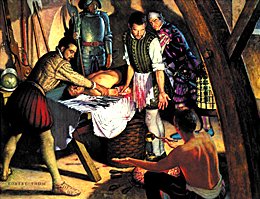 Describe the common types of firearms, and how gunshot wounds do their damage.
Given a gunshot wound, tell whether it is an entry wound
or an exit wound. If it is an entry wound, determine what you can about the range.
Describe the common types of firearms, and how gunshot wounds do their damage.
Given a gunshot wound, tell whether it is an entry wound
or an exit wound. If it is an entry wound, determine what you can about the range.
"The United States is an unusually violent society."
Most of this unit is about violence. Like most other mammals, when we human beings are hurting
and confused at the same time, we have a natural (though lamentable) tendency to lash out against
(blame, physically attack) someone else, regardless of the realities of the situation. We've all seen
individuals do this, and perhaps we've even done this ourselves.


George Orwell wrote, "We sleep safe in our beds because rough men stand ready in the
night to visit violence on those who would do us harm."
Of course, neither I nor anybody else
has any quick fix for a world that is still too violent. You already know the
right-wing and left-wing
crackpot solutions; these would be funny if only....
* Your lecturer is a man of
peace. He predicts that this historical trend will reverse when, and only
when, ordinary people in the poor nations have plenty of private firearms.
Whatever your own feelings about firearms,
if you actually talk with these people, I think they'll tell you the same thing.
* The current left-wing fringe uses terms like
"nontraditional violence" and "implied violence"
for any criticism whatsoever directed against a leftist
individual, leftist agenda, or grievance-group.
Despite what can still happen
on a left-wing campus,
United States law has consistently refused to
recognize such things either as "violence" or "hate speech" or "hate crimes".
 Some episodes
of mass killing (past / present)
get a great deal of attention in the US media and schools; others
get ignored.
In the late 1800's, the Belgians under megalomaniac
King Leopold II looted
the Congo, killing around 10 million people and enslaving, torturing and mutilating
many more. This prompted massive
outrage at the time in the US and Britain but has now been mostly
forgotten.
The genocide in Armenia (about 6 million dead) in the early 1900's
rarely gets mentioned. (In 1939, Hitler, preparing to "kill without pity or
mercy all men, women, and children of Polish race or language", said, "Who still
talks today about the Armenians?")
We almost never hear about
the slaughter of millions of civilians, especially in China,
by the Japanese military as the empire was expanding.
And it's pretty clear that they did
experiment with germ warfare, including plague and anthrax, on civilian
populations.
So as not to "offend" the wrong people,
the popular movie "Pearl Harbor" (2001)
actually portrayed the Japanese as being at peace
before Pearl Harbor.
The greatest mass-murderer of all time
(about 20 million people executed, not counting over 35
million more who died in his
famine) was Mao Zedong.
We hear surprisingly little about
Stalin's policy of slaughtering every Soviet
citizen who had ever made a profit by farming, even though he killed
millions of his own people.
Pol Pot's recent death
got a few sentences in the news; he killed at least a million
people in Cambodia, engaged in systematic electrical torture (Tuol Sleng, elsewhere),
began his attempt to realize his left-wing, anti-Western, back-to-nature fantasy
by shooting everybody who wore eyeglasses, and then banned all institutions
(schools, hospitals banks, stores, and even the family).
Of course a famine followed with about 2 million more deaths.
What has been happening in Central Africa for decades got noticed
only when the "Rwanda genocide" heated up in the mid-1990's; it is now
being ignored once again.
Some episodes
of mass killing (past / present)
get a great deal of attention in the US media and schools; others
get ignored.
In the late 1800's, the Belgians under megalomaniac
King Leopold II looted
the Congo, killing around 10 million people and enslaving, torturing and mutilating
many more. This prompted massive
outrage at the time in the US and Britain but has now been mostly
forgotten.
The genocide in Armenia (about 6 million dead) in the early 1900's
rarely gets mentioned. (In 1939, Hitler, preparing to "kill without pity or
mercy all men, women, and children of Polish race or language", said, "Who still
talks today about the Armenians?")
We almost never hear about
the slaughter of millions of civilians, especially in China,
by the Japanese military as the empire was expanding.
And it's pretty clear that they did
experiment with germ warfare, including plague and anthrax, on civilian
populations.
So as not to "offend" the wrong people,
the popular movie "Pearl Harbor" (2001)
actually portrayed the Japanese as being at peace
before Pearl Harbor.
The greatest mass-murderer of all time
(about 20 million people executed, not counting over 35
million more who died in his
famine) was Mao Zedong.
We hear surprisingly little about
Stalin's policy of slaughtering every Soviet
citizen who had ever made a profit by farming, even though he killed
millions of his own people.
Pol Pot's recent death
got a few sentences in the news; he killed at least a million
people in Cambodia, engaged in systematic electrical torture (Tuol Sleng, elsewhere),
began his attempt to realize his left-wing, anti-Western, back-to-nature fantasy
by shooting everybody who wore eyeglasses, and then banned all institutions
(schools, hospitals banks, stores, and even the family).
Of course a famine followed with about 2 million more deaths.
What has been happening in Central Africa for decades got noticed
only when the "Rwanda genocide" heated up in the mid-1990's; it is now
being ignored once again.
As before, my best prescription is Dr. Virchow's:
reduce the hurting and confusion through real democracy, honest science, reasonable security of
person and property, and access to education and rewarding work.
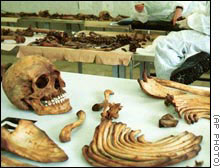
In the next few years, you are going to hear about third-party
payers trying to exclude SPORTS injuries from coverage "because you accepted
the risk voluntarily." This is already on Capitol Hill.
Square this with injuries from alcohol and tobacco
and cocaine and heroin and joining gangs, people.
Especially if you choose rural medicine, you're likely to be called
to the scene when a dead body is discovered.
* Death is a great
disguiser. -- Shakespeare.
Even estimates
of the rate of body cooling (probably best, in the absence of such evidence as bloodstains on the
morning paper) are only moderately useful, as both temperatures at death
and rates of
cooling vary widely.
* Post-mortem rectal temperature time of death
nomogram: For. Sci. Int. 54: 51, 1992; the actual ranges vary hugely;
post-mortem hypoxanthine For. Sci. Int. 51: 139, 1991;
vitreous potassium For. Sci. Int. 46: 277, 1990 &
AMFJP 18: 158, 1997;
CSF chemistry J. For. Sci. 38: 603, 1993. All
about post-mortem chemistry: Am. J. For. Med. Path. 14: 91, 1993.
-- Hamlet
COMPLETING THE DEATH CERTIFICATE
 Homicide: At the very least, someone else did something wrong that set in motion a process that
resulted in the person's death. (The lawyers may decide on "first-degree murder", "second-degree
murder", "voluntary manslaughter", "involuntary manslaughter", "justifiable homicide", or "excusable
homicide.")
Homicide: At the very least, someone else did something wrong that set in motion a process that
resulted in the person's death. (The lawyers may decide on "first-degree murder", "second-degree
murder", "voluntary manslaughter", "involuntary manslaughter", "justifiable homicide", or "excusable
homicide.")
For the past 30 years, the reported suicide rates have hovered
just below 1 in 10,000 people/year, and the report homicide rates
just above this number.
Immediate cause of death is what happened just before, regardless
of the manner of death or the proximate cause. For example, a person who is
accidentally burned and dies three weeks later of pseudomonas sepsis
has sepsis as immediate cause of death, the burn as the proximate cause.
* Mode of death is an unpopular word for what was apparent
without a physician's full workup ("shock", "coma", "pulmonary edema",
"sudden cardiac arrest", "pneumonia").
30 minutes... I can already see lividity on a light-skinned person.
Rigor
may be present.
3 hours... Lividity is usually obvious.
5 hours... Rigor is usually obvious.
10 hours... The body feels cold.
12-18 hours... Rigor is usually maximum.
24 hours... Rigor is usually starting to lyse; this can be later
if it's hot out
2 days... Green discoloration (iron sulfide) on the flanks
2-3 days... Green discoloration on the abdomen
3-4 days... Marbling of the skin begins (red discoloration of surface veins)
5-6 days... Epidermis separates from dermis
2 weeks... Bloated, lots of gas in tissues
3 weeks... Gas causes bursting of the organs, eyes bulge, tissues are soft
4 weeks... Semi-liquid, slime
What's actually happening (I think) is that erythrocyte and
endothelial cell membranes become permeable to hemoglobin; as decomposition
proceeds, the erythrocytes turn to ghosts.
{07195} found in the woods
{07021} found in the pond
{07576} post-mortem roach bites (see also AMFJP 18:
177, 1997)
In big cities, the medical examiner is likely also to have his subspecialty
boards in forensic pathology, i.e., have chosen to devote most of his/her career to this activity.
In some jurisdictions,
the coroner is the medical
examiner.
All homicides and suspected homicides get autopsied.
Future clinicians: Don't mistake any of these for child abuse:
 Shaken baby
Shaken baby
Axonal retraction spheroids
WebPath Photo
7%... motorcyclists
7%... pedestrians
10%... gunshot wounds
10%... stabbings
17%... falls
14%... other (bicycles, industrial accidents, botched suicide attempts, etc.)
Having a pharmacist in the ICU seems to help prevent "adverse
drug events" (no surprise: JAMA 282: 267, 1999).
 Phocomelia
Phocomelia
WebPath Photo
{53781} phenytoin-induced birth defect
 Your lecturer has been observing the drug scene for the past quarter-century. In my honest,
considered opinion, the recreational use of today's illegal drugs has nothing to recommend
it.
Your lecturer has been observing the drug scene for the past quarter-century. In my honest,
considered opinion, the recreational use of today's illegal drugs has nothing to recommend
it.
The physical findings at autopsy in deaths due to drugs are
usually non-specific.
 Cocaine
Cocaine
* Centers or wooden frames are put under the arches of a bridge, to remain
no longer than till the latter are consolidated, and then are thrown away or cast
into the fire. Even so, sinful pleasures are the devil's scaffolding to build a habit
upon; and once formed and fixed; the pleasures are sent for firewood, and hell
begins in this life.
-- Samuel Taylor Coleridge
Cocaine's serum half-life is 1 hour. The post-mortem cocaine levels in people
whose deaths are attributed to cocaine overlap nearly with those in which cocaine's
presence
was an incidental finding.
 Crack lung
Crack lung
Lung pathology series
Dr. Warnock's Collection
 Cocaine lung washings
Cocaine lung washings
Virginia
Good pictures
There's talk of an acquired
channelopathy
(seems unlikely, since it seems to have to do mostly with brain function;
Am. J. Forensic Med. Path. 20: 120, 1999), and some intriguing
work on upregulation of kappa opioid receptors in the amygdala as the
marker for excited delirium (Ann. NY. Acad.
Sci. 877: 507, 1999).
 Cocaine lung
Cocaine lung
Virginia Pathology Cases
 Lacerations and incisions
Lacerations and incisions
Cocaine "excited delirium"
WebPath Photo
* GBH is also a product of decomposition following death,
so post-mortem levels are less helpful. It also is produced in citrated blood
samples simply as they stand. Antemortem blood samples taken in fluoride tubes,
and post-mortem urine are more helpful specimens (Am. J. For. Med. Path. 22:
266, 2001).

Addictive drugs, usually taken by needle (except codeine; intravenous or skin-popping; there are
ways of inhaling "the dragon" heroin). Your lecturer is not impressed with the adverse personality
or health consequences of opiate use itself (well, it's constipating and bad for the libido). However,
the stuff is addictive, expensive, and illegal (which causes some of the problems) and overdose (even
in an addict with marvelous tolerance) is very lethal.
 Unlike cocaine, heroin is not known to have any direct
tissue toxicities.
There are maybe 4000 deaths from heroin overdose in the US each year.
Those dying of heroin overdose either (1) stopped breathing from medullary depression, or (2) got
pulmonary edema (nobody knows why opiates can do this, but it's
likely that it's neurally-mediated, because of tolerance and because
brain injury itself can produce similar edema). Of course, there are plenty
of heroin-related deaths due to lifestyle and/or unsanitary injection
practices.
Unlike cocaine, heroin is not known to have any direct
tissue toxicities.
There are maybe 4000 deaths from heroin overdose in the US each year.
Those dying of heroin overdose either (1) stopped breathing from medullary depression, or (2) got
pulmonary edema (nobody knows why opiates can do this, but it's
likely that it's neurally-mediated, because of tolerance and because
brain injury itself can produce similar edema). Of course, there are plenty
of heroin-related deaths due to lifestyle and/or unsanitary injection
practices. It's commonplace for an
"accidental" overdose to have been preceded by a critical life-event, and many of these "unfortunate
tragic accidents" are probably suicides (Forens. Sci. Int. 62: 129, 1993).
* Future medical examiners: The S-enantiomer of methadone is inert
but is measured by some of the toxicology techniques.
 Heroin-cocaine death
Heroin-cocaine death
Note foam around mouth
Supposedly Chris Farley
* An outbreak of anthrax among skin-poppers whose heroin was
mixed with dirt: Science 288: 1941, 2000; Lancet 356:
1574, 2000.
 Starch granules in tissue
Starch granules in tissue
Warning: Gross out
Dino Laporte's PathosWeb
* The classic teaching that needle-users get lots of
siderophages in the lungs is challenged: Forens. Sci. Int. 59: 169, 1993.
 Crystals in the lungs of drug abusers
Crystals in the lungs of drug abusers
Lung pathology series
Dr. Warnock's Collection
 Absinthe
Absinthe"The green muse" was a liqueur distilled from wormwood
and sometimes other herbs, was popular in the late 1800's. It affected its users
more radically than did other alcoholic beverages, producing a different kind
of acute intoxication, then addiction, brain damage, and psychosis. Review
Br. Med. J. 319: 1590, 1999.
 The special ingredient which produced the weird intoxication is supposedly
thujone. If you believed everything you read about this, you'd be reading
uncritically. Despite its molecular resemblance to the active ingredient
of marijuana, it doesn't work on the cannabinoid receptors.
More credible is work showing that it acts on the GABA type A receptors
(Proc. Nat. Acad. Sci. 97: 3826 & 4417, 2000). This suggests
excitotoxicity as the cause of the permanent brain damage.
The special ingredient which produced the weird intoxication is supposedly
thujone. If you believed everything you read about this, you'd be reading
uncritically. Despite its molecular resemblance to the active ingredient
of marijuana, it doesn't work on the cannabinoid receptors.
More credible is work showing that it acts on the GABA type A receptors
(Proc. Nat. Acad. Sci. 97: 3826 & 4417, 2000). This suggests
excitotoxicity as the cause of the permanent brain damage.
After the first glass you see things
as you wish they were. After the second, you see them as they
are not. Finally, you see things as they really are,
and that is the most horrible sight in the world.
-- Oscar Wilde
Cannabis (marijuana, pot, grass, hashish, etc.; "I did not inhale" -- Bill; "Life
is way too short to be self-absorbed"
-- Ed)
What did the two stoners say to each other when they finally ran out of marijuana?
"Hey, this music sounds terrible!"
* Your lecturer predicts that the brain receptors responsible
for the nausea of chemotherapy will turn out to be the CB1 receptors,
which use anandamine. CB1 blockers exist and produce severe nausea.
Nobody is looking at clinical uses for these blockers,
which tells me that nobody really believes that marijuana smoking is
a major menace
to individuals or to society.
 Drug testing (review Clin. Lab. Med. 18: 781, 1998
Drug testing (review Clin. Lab. Med. 18: 781, 1998

 * All about the "war on drugs": NEJM 330: 357, 1994; JAMA 273: 1143, 1995,
update Lancet 357: 971, 2001; "a quagmire for our times J. Pub. Health Policy 23: 286, 2002.
It is one of the mainstays of "politics as usual".
Talking about this subject is now considered appropriate for the classroom.
The war on drugs
directly consumes about $17 billion of our tax dollars per year. There are around 3.5-4 million
hard-core addicts (cocaine, crack, heroin), mostly underclass, who are
doing most of the crime (robbery, shoplifting, low-level dealing,
also child neglect and abuse.)
Nobody likes people being addicted to drugs like cocaine and heroin. But
despite the rhetoric, it is obvious that vested interests
are in control of drug policy.
Addiction treatment on demand
remains unavailable for most people (Am. J. Psych. 151: 631, 1994; Forens. Sci. Int. 62: 129,
1993; Am. J. Pub. Health 89:
657, 1999).
The unavailability of treatment is, of course, the result of politics. (Nancy Reagan's
"Just Say No!" campaign, the Republican-Right response to conservative suburbanites
who wanted the government to focus on preventing their children from
smoking marijuana, ended the Nixon-Carter policy of quietly providing
detoxification. Conversely, communities which profit massively from the drug
trade strongly oppose detoxification -- their
left-wing rhetoric is "curious".)
Thankfully, cheap detoxification is becoming
more available, but for decades, an addict would have to wait
months; this satisfies me that neither the "liberal" nor the
"conservative" politicians really wanted criminals/addicts off the streets.
(You'll hear the current strategy of interdiction compared to
the game "whack-a-mole".
Notice that neither "liberal" nor "conservative" politicians
ever talk about military action against the cocaine and heroin
lords. Is this because they both benefit from
the status quo? Or is it because they realize that this
wouldn't work?)
Drug addiction is notorious for relapsing, and no one expects
that methadone maintenance patients will really remain free of
street drugs, only that the maintenance will diminish their illegal
activities (JAMA 281: 1000, 1999).
Drug-related crime has turned our inner cities into war zones
(there were around 1500 drive-by shootings in 1995 in Los Angeles alone),
young children are brought into criminal lifestyles by drug dealers
since they will be punished less severely when caught,
and drug-related crime
is the #1 or #2 concern of Americans in the surveys lately
(after the health-care mess of course).
Pediatrics 93: 1050 & 1065, 1994
showcases the disastrous effects on black males ages 9-15; this is one you oughta read, though I
don't know whether the "multilevel strategies" the left-wing authors propose will solve the problem
while the "war on drugs" continues and there's easy money to be made by those who are not "future-oriented".
Drug availability
is undiminished (because it is illegal, a high school kid has a much
easier time getting marijuana than alcohol),
and the number of deaths from drug overdose (not to
mention the associated crime and that retroviral disease which is still increasing among IV drug
abusers) continues to increase. At least we are putting away more drug dealers, who now occupy a
third of our penitentiary spaces (additional $$ beyond the $17 billion/year). Parents: If you don't
take a personal, friendly interest in your kids and their happiness, then the local drug dealer
probably will. and if
you have given your kids nothing credible to feel part-of, then the local drug culture
probably will. The case for
continued prohibition of the recreational drugs is persuasive for many people (who generally assume
that decriminalization / legalization would increase drug use, which you might reasonably doubt).
But their arguments could be applied equally well to alcohol and tobacco (Nature 374: 391, 1995) -- but you knew that.
* All about the "war on drugs": NEJM 330: 357, 1994; JAMA 273: 1143, 1995,
update Lancet 357: 971, 2001; "a quagmire for our times J. Pub. Health Policy 23: 286, 2002.
It is one of the mainstays of "politics as usual".
Talking about this subject is now considered appropriate for the classroom.
The war on drugs
directly consumes about $17 billion of our tax dollars per year. There are around 3.5-4 million
hard-core addicts (cocaine, crack, heroin), mostly underclass, who are
doing most of the crime (robbery, shoplifting, low-level dealing,
also child neglect and abuse.)
Nobody likes people being addicted to drugs like cocaine and heroin. But
despite the rhetoric, it is obvious that vested interests
are in control of drug policy.
Addiction treatment on demand
remains unavailable for most people (Am. J. Psych. 151: 631, 1994; Forens. Sci. Int. 62: 129,
1993; Am. J. Pub. Health 89:
657, 1999).
The unavailability of treatment is, of course, the result of politics. (Nancy Reagan's
"Just Say No!" campaign, the Republican-Right response to conservative suburbanites
who wanted the government to focus on preventing their children from
smoking marijuana, ended the Nixon-Carter policy of quietly providing
detoxification. Conversely, communities which profit massively from the drug
trade strongly oppose detoxification -- their
left-wing rhetoric is "curious".)
Thankfully, cheap detoxification is becoming
more available, but for decades, an addict would have to wait
months; this satisfies me that neither the "liberal" nor the
"conservative" politicians really wanted criminals/addicts off the streets.
(You'll hear the current strategy of interdiction compared to
the game "whack-a-mole".
Notice that neither "liberal" nor "conservative" politicians
ever talk about military action against the cocaine and heroin
lords. Is this because they both benefit from
the status quo? Or is it because they realize that this
wouldn't work?)
Drug addiction is notorious for relapsing, and no one expects
that methadone maintenance patients will really remain free of
street drugs, only that the maintenance will diminish their illegal
activities (JAMA 281: 1000, 1999).
Drug-related crime has turned our inner cities into war zones
(there were around 1500 drive-by shootings in 1995 in Los Angeles alone),
young children are brought into criminal lifestyles by drug dealers
since they will be punished less severely when caught,
and drug-related crime
is the #1 or #2 concern of Americans in the surveys lately
(after the health-care mess of course).
Pediatrics 93: 1050 & 1065, 1994
showcases the disastrous effects on black males ages 9-15; this is one you oughta read, though I
don't know whether the "multilevel strategies" the left-wing authors propose will solve the problem
while the "war on drugs" continues and there's easy money to be made by those who are not "future-oriented".
Drug availability
is undiminished (because it is illegal, a high school kid has a much
easier time getting marijuana than alcohol),
and the number of deaths from drug overdose (not to
mention the associated crime and that retroviral disease which is still increasing among IV drug
abusers) continues to increase. At least we are putting away more drug dealers, who now occupy a
third of our penitentiary spaces (additional $$ beyond the $17 billion/year). Parents: If you don't
take a personal, friendly interest in your kids and their happiness, then the local drug dealer
probably will. and if
you have given your kids nothing credible to feel part-of, then the local drug culture
probably will. The case for
continued prohibition of the recreational drugs is persuasive for many people (who generally assume
that decriminalization / legalization would increase drug use, which you might reasonably doubt).
But their arguments could be applied equally well to alcohol and tobacco (Nature 374: 391, 1995) -- but you knew that.
-- Albert Einstein

* Criminal poisoning by thallium and arsenic in an auto manufacturing
plant: Ann. Emerg. Med. 39: 307, 2002.
A near-miss homicide, described by the victim, who was crippled:
South. Med. J. 96: 632, 2003.
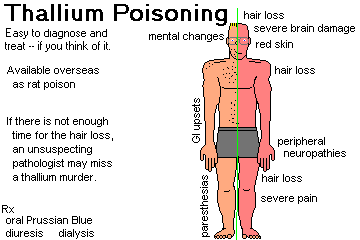
 Elemental mercury is the familiar liquid metal ("quicksilver", etc.) People are often exposed at
work. (Everybody knows that mercury in old-fashioned felt caused insanity
in hatmakers.) It produces a toxic encephalopathy, with difficulty speaking, clumsiness, and behavioral
problems. More subtle cases may mimic amyotrophic lateral sclerosis.
Elemental mercury is the familiar liquid metal ("quicksilver", etc.) People are often exposed at
work. (Everybody knows that mercury in old-fashioned felt caused insanity
in hatmakers.) It produces a toxic encephalopathy, with difficulty speaking, clumsiness, and behavioral
problems. More subtle cases may mimic amyotrophic lateral sclerosis.
Despite much effort, nobody's been able to link intake of methylmercury
in fish to brain dysfunction, even in the Seychelle islands where exposure high
(Lancet 361: 1686, 2003).
 Mercury poisoning
Mercury poisoning
Striking coagulation mecrosis
of proximal tubules
KU Collection
* The yield among those living in better homes is essentially zero, but
universal screening is still the recommendation, probably to avoid charges of "classism".
 Arsenic (Lancet 347: 1596, 1996)
Arsenic (Lancet 347: 1596, 1996)
* When he finished his internship,
Michael Swango MD got his revenge on his attending staff using arsenic,
but nobody died that time.
Swango's long career as a serial killer was enabled mostly (it seems to me)
by physicians' fear of being sued.
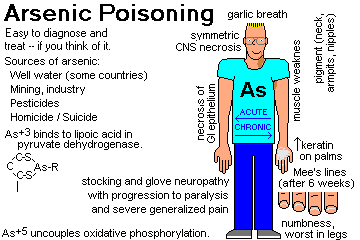
 Mee's transverse leukonychia
Mee's transverse leukonychia
These were from chemotherapy
New England Journal of Medicine
A robin, since the DDT... -- c. 1962
 Organophosphate poisoning
Organophosphate poisoning
Pittsburgh Pathology Cases
 CAFFEINE
CAFFEINE
 ALCOHOL (ethanol, ethyl alcohol, "grain alcohol", etc.)
ALCOHOL (ethanol, ethyl alcohol, "grain alcohol", etc.)
When I put my arms around you and kiss you on your mouth,
Then I am happy even without beer!
The best of life is but intoxication.
{37891} wino crossing
 It would be difficult to overstate the contribution of excessive
alcohol drinking to ill-health, the patient load of a
general hospital, or the business of a Medical Examiner's office. The behavioral changes in acute
and chronic alcoholism require no description here.
It would be difficult to overstate the contribution of excessive
alcohol drinking to ill-health, the patient load of a
general hospital, or the business of a Medical Examiner's office. The behavioral changes in acute
and chronic alcoholism require no description here.
* Your taxes paid for an expensive government
anti-alcohol program
specifically targeted
at
fraternity and sorority members.
Most of the older Greeks refused
even to sit through the eight-hour indoctrination session. Those that did mostly
refused to give the
answers that the government wanted to prove their program worked.
The authors were truthful enough about the fiasco, and this simply confirmed my old Al-Anon
wisdom, "You cannot control another person's drinking."
See J. Stud. Alcohol 60: 521, 1999.
 * Future pathologists: Post-mortem ethanol levels are a subject
of much interest. Worth knowing:
* Future pathologists: Post-mortem ethanol levels are a subject
of much interest. Worth knowing:
Blood levels are a bit lower than serum levels because serum has more water, and of course
ethanol is distributed through the aqueous phase.
 Type I is memorialized in "The Little Prince": "I drink to forget... to forget that I am ashamed...
ashamed of drinking!") Type II tends to run in families and announce itself early.
Type I is memorialized in "The Little Prince": "I drink to forget... to forget that I am ashamed...
ashamed of drinking!") Type II tends to run in families and announce itself early.
The classic kid with fetal alcohol syndrome has a long upper lip, epicanthic
folds, a small head, and
is mildly mentally handicapped. There's a lot of variability. Alcohol
causes apoptosis of fetal neurons: Science 287: 1056, 2000.
* Thanks to the savvy pathologist testing the vitreous, we knew that Henri Paul,
who was driving Princess Diana, really DID have a blood alcohol level of
around 175 mg/dL when he crashed (Br. Med. J. 316: 87, 1998).
By federal law, all US ethylene glycol has added fluorescein,
so the urine of an antifreeze-drinker fluoresces under your Wood's lamp.
Handy in the emergency room.
* No surprise: More underclass people die unnatural deaths
in the days after the end-of-the-month
check comes than in the days before the end-of-the-month check
comes. The difference is explained by drugs and alcohol (NEJM 341: 93,
1999).
An armed society is a polite society.
-- Robert Heinlein


{07252} how an abrasion ring forms


What really comes from the barrel of a gun? Flaming gas, soot, unburned gunpowder, and a bullet.
These can tell you how far the gun may have been from the victim.

 In order to get a reliable estimate of the range, the particular gun and type of ammunition must be
test-fired. Future medical examiners: In looking for powder and soot, remember to check the
clothing, too. Future pathologists: Silencers absorb much of the smoke and powder.
In order to get a reliable estimate of the range, the particular gun and type of ammunition must be
test-fired. Future medical examiners: In looking for powder and soot, remember to check the
clothing, too. Future pathologists: Silencers absorb much of the smoke and powder.
 Distant range cutaneous entrance wounds: No powder, soot, or stellate blow-out. (Of course, if the
victim was shot through clothing, check to see if there's powder or soot on the clothes.)
Distant range cutaneous entrance wounds: No powder, soot, or stellate blow-out. (Of course, if the
victim was shot through clothing, check to see if there's powder or soot on the clothes.)
Note that real-life people who get shot seldom simply fall over, like they do in the movies. Leave
medicolegal stuff (direction of fire, range of fire, number and sequence of shots fired, time and
degree of disability) to us.
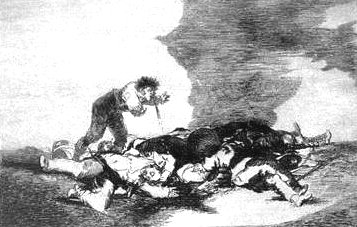
{07079} abrasion ring
{07080} abrasion ring
{07630} muzzle imprint
{07083} bullet fractured skull, note bevel
{07235} bullet fractured skull, note bevel
{07325} supra-orbital plate shattered
{07089} powder stippling ("tattooing")
{07033} powder stippling
{07090} bullet graze
{07091} shotgun wound, close-up
{07173} shotgun wound
{07229} shotgun wound
{07093} suicide, gun in mouth
{07095} powder residue on hand
{07132} gunshot wound and beating
{07102} through and through
{07111} stellate wound
{07231} stellate wound
{07034} exit wound
{07035} bullet through brain
{07171} histology of entry wound, with char
{48999} shot in the heart

 President Garfield's spine
President Garfield's spine
injury (gunshot assassination)
AFIP
 Tight contact wound
Tight contact wound
Abrasion ring and muzzle imprint
WebPath Photo
 Tight contact wound
Tight contact wound
Abrasion ring and great muzzle imprint
WebPath Photo
I've examined various
writings from various sides, and have decided there's
nothing too puzzling about it, at least from the standpoint
of the pathology. "Oswald acted alone" probably
isn't provable one way or the other, but the pathology
is interesting.
BLUNT TRAUMA
{07051} child abuse
{07036} car wreck

Tearing, shearing, and crushing. The amount of damage delivered by a blow from a blunt object
varies directly with:

{07064} abrasion

{07072} blunt-thing wound
{07591} blunt-thing wound

 Open fracture
Open fracture
Not wearing a seat belt
WebPath Case of the Week
 Transected pulmonary artery
Transected pulmonary artery
Car wreck
Pittsburgh Pathology Cases
 Blunt trauma to the heart and pericardium
Blunt trauma to the heart and pericardium
 Ripped aorta
Ripped aorta
Car wreck
WebPath Photo
{07148} fat embolus (brain capillary)
{07149} fat embolus (bone marrow in lung artery)
 Cannonball injury
Cannonball injury
General Sickles
AFIP
 Legs amputated by a train
Legs amputated by a train
Drug dealer punished by
another dealer -- EMBBS
-- Shakespeare's Mercutio
{07043} stab wound of head
{07066} stab wound
{07071} stab wound
{07131} stab wound
{07031} stab wounds
{07160} stab wound, knife guard went in
{38252} stab wound of chest
{38256} stab wound of chest
 Ronald Goldman's
Autopsy
Ronald Goldman's
Autopsy
Text only
Not for young or sensitive viewers
|
|
 Most fatal stab wounds are knife homicides. You can distinguish wounds by sharp instruments from
lacerations by:
Most fatal stab wounds are knife homicides. You can distinguish wounds by sharp instruments from
lacerations by:
The sharper the knife, the easier it is to penetrate the skin. Once the skin is penetrated, it's very easy to go deeper until bone is hit.
Note that a dull knife will give abraded, bruised margins, and a very dull knife will give jagged, contused margins.
If tremendous force is used, you may see the pattern of the knife guard. If both ends of a stab wound are blunt, the ricasso (i.e., the area near the guard where both edges are dull) or the guard itself actually went in.
Knowledgeable perpetrators twist the knife, once inserted, to allow lungs to collapse and vessels to be opened. This is likely to turn the skin wound into a "V", "L", or "Y".
In the real world, it's impossible to determine the size or shape of a knife from the wounds produced.
If the blade is not completely inserted, the track will be shorter than the blade. If great force is used, the track will be longer than the blade. (Remember that the chest wall can be deformed easily.)
If the blade is not completely inserted, the skin wound may be narrower than the blade. If the knife is not moved straight in and out, the skin wound may be wider than the blade.
The elasticity of the skin may also make the width of the wound a few millimeters wider or narrower than the blade (how?)
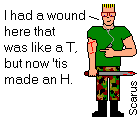 The shape of any knife wound will be determined mostly by Langer's lines (remember those?). If
the wound is perpendicular to the lines, it will gape. If it is parallel, it will remain slit-like.
The shape of any knife wound will be determined mostly by Langer's lines (remember those?). If
the wound is perpendicular to the lines, it will gape. If it is parallel, it will remain slit-like.
Here's a thought question. What are the ways that scissors stab wounds might look?
If the knife has a sharp and a dull edge (most U.S. knives do), one end of the entry wound may be more pointed than the other. In reality, both ends are usually sharp, since the knife usually enters obliquely and cuts as it goes, and in any case, both sides of the actual knife tip are often sharp.
If there are multiple stab wounds, it's easier to make an educated guess about how thick and how long the weapon was.
Future pathologists: Don't probe knife wounds much. You'll make them deeper and learn nothing useful.
You can produce a fatal stab wound with anything sharper than a table fork.
Scissors (open or closed), barbecue forks, Phillips screwdrivers, broken bottles, and arrows (target or hunting) all produce fairly distinctive wound patterns. Arrow wounds in North Dakota: J. For. Sci. 34: 579, 1989; in Georgia J. For. Sci. 34: 691, 1989. Nail gun suicides: AJFMP 11: 282, 1990.
Some clever perpetrators deliver a single icepick blow into the auditory meatus, hoping the
pathologist will miss the entry wound and also decide, "Must be sudden coronary death, we don't
need do to the head."
Stab wounds kill by involving an important organ.
When the heart is involved, death usually results from hemopericardium and tamponade.
When the great vessels are involved, death usually results from hemothorax or hemoperitoneum.
When the lungs are involved, death usually results from hemothorax, less often from pneumothorax.
When the gut is perforated, death usually results from peritonitis.
Neck wounds (stab or incised) kill by producing air embolization, asphyxiation, or exsanguination.
Death may also be due to compression of neck structures by a large hematoma.
In stab wounds of the brain, the patient often does not lose consciousness, at least immediately.
Fatal hemorrhage from a stab wound of the extremity is rare unless the femoral artery is severed.
{53702} guy with "behavioral disorder"
Incised wounds
Injury from something sharp (like a stab wound), broader than it is deep (in contrast to a stab
wound). A "slash".
{07388} incised wounds
A person may commit suicide by severing an artery, broken glass may cut the neck, or a neck
wound inflicted by a perpetrator may be fatal. (In neck wounds, death is likely to result from air
embolism.) A drunkard or druggie may die after punching out a pane of glass. Other incised
wounds are very rarely fatal.
Future medical examiners: (1) "Hesitation marks" are very superficial cuts made by the wound-be
suicide, prior to making the fatal deep cut. They are generally present if it's a suicide. However,
perpetrators may also hesitate. (2) Would-be suicides seldom shoot, cut or stab themselves through
clothing. (3) Perpetrators and would-be suicides will use their dominant hand and locate their cuts
accordingly. (4) You'll see "defense wounds" on the palms (grabbed the knife), the backs and ulnar
aspects of the arms, and sometimes the legs. (5) Homicidal incisions of the neck are usually long
and deep if inflicted from the rear, short if inflicted from the front.
{07398} throat was cut
Most incised wounds have very shallow ends. A "wrinkle wound" is several discontinuous incised
wounds, caused when a knife wrinkles the skin, cutting only the crests.
{07383} wrinkle wound
The dimensions of an incised wound tell you nothing about the weapon with which it was made.
Again, Langer's lines determine whether the wound will gap. (NOTE: "Gap" is a real verb, cognate
to "gape".)
Chop wounds are categorized separately because they combine features of incised wounds and
lacerations, or may appear intermediate.
Machete, meat-cleaver, and propeller wounds belong in this category.
Typically, a chop wound will produce an obvious defect in the underlying bone. Depending on how
sharp the instrument is, the overlying wound may appear to be an incision or a laceration.
*How the pathologists approached one of the Jeffrey Dahmer murders: J. For. Sci. 38: 985, 1993.
LACK OF AIR:
{07045} suffocation
Entrapment and environmental suffocation
Suffocation is usually accidental, from entering or
being trapped where there's too little oxygen
(i.e., in a high, un-pressurized airplane,
in a fire, in a long-closed rusted-out tank,
or
deep in a mine with saprophytes and methane) or insufficient air flow (i.e., as oxygen is
depleted by the victim, death results; typical case is a kid in an abandoned refrigerator).
Citations of "fatally low percentages of oxygen in the air" recall the hemoglobin-oxygen dissociation
curve. Below around 60 torr, the hemoglobin thinks it's supposed to give up oxygen, not take it on
board.
At autopsy, you'll find nothing specific.
* Africa's Lake Nyos and other volcanic
killer lakes emit carbon dioxide episodically, with mass
deaths: J. Forensic Sci. 33: 899, 1988,
Br. Med. J.298: 1437, 1989; Sci. Am. 283: 92, July 2001, Nature 409: 554, 2001.
* Relatively common today, thanks to some books promoting it,
is suicide by helium or some other inert gas, used to flush oxygen from a plastic bag over the head.
Am. J. For. Med. Path. 24: 306, 2003.
Smothering
Death from occlusion of the mouth and nose by something pressing on the face.
Smothered homicide victims are the very old, the very young, the very sick, or the very intoxicated.
The preferred instrument is the pillow or wet washcloth,
or the face may be pushed into the bedding. Or the nose and
mouth may be occluded using the hands. For the very debilitated, a wet
washcloth is sufficient. The most you will see at autopsy are petechiae (sclerae,
conjunctivae), nail marks, and bruising of the lips. Even these will probably be absent.
Positional asphyxia simply due to bedrails is well-known (Lancet 363:
343, 2004). Having the bedrails up
might help against lawsuits, but also means that patients who climb over
them (to go to the bathroom or for whatever reason)
are much more likely to fall and to fall farther. (I'm a sleeping-bag man
myself....)
{12354} smothered?
Less often, homicidal smothering results from inept use of gags by perpetrators. Usually, the victims
are elderly robbery victims.
Suicides favor the types of plastic bags from the dry cleaner's. "Hemlock Society" suicides favor
oral overdosage on a Mexican benzodiazepine followed by placing a plastic bag over the face.
As you would expect, where there is no struggle for breath,
there will be no petechiae (AJFMP 17: 308, 1996).
In children, death due to smothering by a plastic bag is a common accident. If a mattress is too
small for the crib, the child can smother in the gap between them.
*Your lecturer claimed for many years, contrary to classic teaching, that a child or passed-out
drunkard or druggie can smother on bedclothes or a mattress.
We now know that this is
one of the major causes of "SIDS". More later.
Whether the death is homicidal, suicidal, or accidental, autopsy findings will usually be entirely
negative.
Choking
Obstruction within the air passages. When "natural", the cause is epiglottitis. Your lecturer has
seen accidental deaths due to a roll of sliced ham ("just popped it in..."), a section of canned peach, a
swollen tongue chewed during DT's, and a set of dentures.
Homicidal choking usually results either from (1) stuffing a baby's mouth with toilet paper to stop
its crying, or (2) using a rag in the mouth in conjunction with a gag.
Most deaths from choking are accidents. Common objects in kids include peanuts, un-popped
popcorn kernels, little balls and screws, and the caps of ball-point pens. In grown-ups, the "café
coronary" usually results from a drunkard swallowing poorly-chewed beef "down the wrong throat".
Less often, pills can end up in the airway, or falling into deep sawdust, grain elevators, etc., can
cause death.
{07213} candy corn occluding airway
Don't accept "laryngospasm" as a cause of death. The larynx would relax when hypoxia becomes
severe.
However, classic textbooks of forensic pathology give little play to airway obstruction in
unconscious or very debilitated patients due to the tongue. Ask any anesthesiologist; this is
important, and probably is the final pathway out of life for many people.
Pressure outside the body can also cause asphyxia. Familiar causes include large snakes (J. For. Sci.
34: 239, 1989), riot crush,
falling into grain (kills a few dozen agricultural workers each year),
garage doors (kids playing with the automatic opener: Ped. 98: 770, 1996),
human piles, and cars falling off the jack onto your chest. Each time you
breathe out, your chest is further constricted. When you try to breathe back in, you cannot.
At autopsy, you'll see bruises, petechiae all over the conjunctiva and sclera, and impressive
congestion of the head. (* Future medical examiners: Lots of things can give you petechiae on the
eyes by producing strong pressure waves. See, for example, J. For. Sci. 38: 203, 1993).
An important variation is positional asphyxia. In this situation, someone slips into a confined space,
and each exhalation causes the person to slip deeper.
STRANGULATION: Occlusion of the blood flow and/or air passages in the neck by external
compression.
In any strangulation, death is due to lack of oxygen to the brain. While the carotids are easy to
compress, it takes severe twisting of the neck to occlude the vertebral arteries. Nothing you can do
will occlude Batson's plexus, which is an important part of the venous drainage of the brain.
In hangings, the pressure is often great enough to prevent most arterial flow to the head, and
therefore, you will not see petechiae. In fatal ligature and manual strangulation (and often
but not always in smotherings), there will always be petechiae on the conjunctivae. The finding is by no means
specific; you can see petechiae here in death from right-sided heart failure, after vomiting, or even
from lying face-down after death.
*Shakespeare's Desdemona is strangled / smothered
by her husband
and left for dead. Emilia comes in. Desdemona
revives briefly, speaks, then dies.
Either this is Shakespeare's poetic license (seems most likely)
or she was rendered unconscious by occlusion of the mouth-and-nose,
trachea, and/or carotids, then revived, succumbing moments later to
increasing edema of the tongue-throat or larynx
from injury during the struggle. Alternatively, the director
can have Othello stab Desdemona to death in front of Emilia.
This has been done with much impact.
It's difficult to occlude the airway by compressing the neck. If
this is done, it's done by pushing up on the larynx and hyoid to occlude
the back of the throat.
* The Whitechapel serial killer ("Jack the Ripper")
was neither the first nor the last serial killer of prostitutes, but was
the first to gain a great deal of media attention. When the woman lifted
her skirts and thus had both hands occupied, the killer strangled
her, probably pushing the larynx up or compressing it from both sides in
order to prevent a loud cry. He then laid the body down gently on the ground,
turned the head to the left, stood on the right
side, and cut the left side of the throat to prevent blood from squirting
onto himself.
Like others of his kind,
he took anatomic souvenirs.
He did not have sex with, or masturbate over, the bodies.
Probably we will never find out who "Jack the Ripper" actually was.
*Sphincter incontinence is common in strangulation, but by no means inevitable. Erection and
ejaculation during judicial hanging are probably legends.
Hanging: Compression of neck structures is secondary to a noose tightened by body weight. Review
of the anatomy: Forens. Sci. Int. 56: 65, 1992.
Most of these are suicides. The weight of the head (12 lb) slightly exceeds the weight required to
compress the carotids. The victim may be fully suspended, upright with
legs on the floor, kneeling, sitting, or lying down. It takes 33 lb
of pressure to compress an adult's trachea, so this usually doesn't happen
in a hanging. Sometimes, death is due to the tongue being forced
upward to occlude the airway.
You'll usually find the noose above the larynx. Look for marks, unless the ligature is soft and the
body was taken down soon after death.
After most hangings, you'll see a protruding tongue.
Don't expect always to see deep injuries in the neck, or petechiae around the eyes (why not?)
Tardieu spots are small hemorrhages resulting from the weight
of a column of blood rupturing blood vessels after death. These can be impressive
in the lower extremities of a hanged body.
{07046} hanging
In judicial hanging, the "client's" upper cervical vertebrae (C2, C3, and/or C4) are supposed to be
broken and/or dislocated by a carefully-planned drop (* actually, doing this right is the exception:
For. Sci. Int. 54: 81, 1992). Suicides won't be able to do this unless they have cancer, Down's
(maybe), rheumatoid arthritis, or osteoporosis weakening the vertebral column.
Sexual (autoerotic) asphyxia: A curious, fairly common accident in which a man hangs himself
while acting out his personal, private, kind-of-unusual sexual fantasies.
You are likely to find (1) a towel or cloth between the rope and the neck, to avoid producing a hard-to-explain mark
afterwards; (2) dirty books and pictures, women's clothing, a mirror, and/or maybe
even a camera; (3) some kind of evidence that this isn't the first time (i.e., check that closet top for
rope marks); (4) something to prevent his semen from splattering; (5) the deceased could have tied
himself up that way. Review AJFMP 16: 232, 1995.
Your lecturer doesn't believe these men do this stuff "because hypoxia heightens orgasm". If this
were true, more men would ask their wives and girlfriends to squeeze
their necks during romantic interludes. Being tied up is a well-known turn-on for lots of men, alone
or with their special partners. Danger may also be a thrill (I wouldn't
know, skydiving is very safe).
Guys: if you do this stuff, just don't tie the rope around your neck when you're alone.
*Different things are turn-ons for different men, and some men inhale icky things rather than tying
themselves up. Your lecturer autopsied one 15-year-old who suffocated on "Pam" pan spray while
masturbating. These are all accidents, not suicides. Two different guys and their accidentally-fatal
romantic relationships
with
their hydraulic tractor shovels: J. For. Sci. 38: 359, 1993. Also Psych. Clin. N.A. 15: 703, 1992
("the dangerous paraphilias", enough to make it obvious enough that it's the link with physical danger that's a
turn-on).
*Once considered a "men-only" phenomenon, we now know that a few women do this stuff, too.
The difference is that women almost never use props, toys, or funny clothes (For. Sci. Int. 48: 113,
1990).
Homicidal hanging is rare, but a very clever perpetrator who is alone with the victim in a private place
can render the victim
unconscious by a blow to the head and then hang him. The subgaleal hematoma will be the giveaway. Authentic-looking noose marks can be made on a body if it is
hanged two hours or less after being murdered by some other means. When in doubt, a complete
autopsy is worthwhile.
*Grammarians: People are "hanged", inanimate things are "hung". The only exception is when a
man is bragging (or, less likely, getting a compliment) about his equipment.
These are usually homicides, and the victims are usually women. An occasional enterprising suicide
may use a tourniquet method, and lie on the stick to hold it in place. Accidental ligature
strangulations occur (for example, Isadora Duncan's scarf, some skydiving mishaps).
The appearance of the mark can be highly variable. If a towel is used, there may be none. Future
pathologists: Don't mistake ordinary crease marks of newborns, folks with jowls, or decomposed
people for ligature marks.
Again, there will always be conjunctival petechiae.
{07189} ligature strangulation
Manual strangulation: Compression of neck structures by someone else's body part.
This is always homicidal. (Possible exception: Someone bumps his own carotid sinus and has a
rhythm disturbance. I think this is very unlikely unless the person is already very sick. Anyway,
this hardly counts as "manual strangulation".)
There will always be conjunctival petechiae. Usually, the force used is sufficient to produce
hemorrhage. Older people tend to have more extensively calcified (and therefore breakable) thyroid
cartilage horns, hyoid bones, and tracheas. Ante-mortem fractures of the hyoid bone are
pathognomonic of manual strangulation. As usual, there must be hemorrhage, or you can't call a
fracture ante-mortem. All about hyoid bones and strangulation: J. For. Sci. 37: 1216, 1992.
Again, look for nail marks ("claw marks", "scratch marks"), little bruises, and so forth. "Clever"
perpetrators strangle drunkards and children using the palm, without producing finger marks or
damaging the deep structures of the neck. In this case, there may be no marks.
*Medical historians! Burke and Hare, old-time Scottish
medical school anatomy department provisioners, decided that
robbing new graves was too much work. They started obtaining the corpses of poor folks by
"burking", i.e., sitting on the chest and occluding nose and mouth with their palms.
{07047} strangled by hand
* Future pathologists: If you suspect strangulation, open the
head before you dissect the neck. This will prevent overdistended
veins, especially between esophagus and spine, from rupturing and
confusing the picture.
Future criminal-justice types: Choke holds (really, "bar arm holds") may produce death by
(1) fracturing the airway, (2) hypoxia sensitizing the heart to rhythm disturbances induced by
catecholamines during the continuing struggle, or (3) atheroembolization. Carotid sleeper holds
compress the carotids only, but as the recipient struggles, the neck can be damaged.
Future medical examiners: Blood behind the esophagus, or next to the cervical spine, or petechiae on
the laryngeal and epiglottis mucosa mean nothing. Don't send somebody to jail for a non-strangling.
CHEMICAL ASPHYXIA
Hydrogen cyanide, carbon monoxide, and hydrogen sulfide (oil refineries,
manure pits, geothermal plants) are poison gases.
Cyanide (JFMP 18: 185, 1997; Am. J. For. Med. Path.
23: 315, 2002):
Blocks the cytochrome system.
Cyanide sodium and potassium salts are used in electroplating, as fumigants, and as insecticides.
There is marked dyspnea before death, and criminals in the gas chamber have signalled that death
from cyanide gas is, indeed, painful.
* Burning plastics produces cyanide, and often people who die in
household fires have lethal levels of cyanide in their blood.
Unlike in the spy movies, it always takes a few minutes to die of cyanide poisoning, even when it is
in gas form, and victims remain conscious for a while. (This happened in the Nazi death camps, and
in the gas chambers used for capital punishment.) You need around a fifth of a gram of either the
salt or the gas; when the salt is ingested, stomach acid (if present) turns it into the lethal gas.
(* NOTE: Rasputin probably had achlorhydria; why?)
At autopsy, look for (1) bright red blood (i.e., cyanide prevents utilization of oxygen) (2) the "bitter
almonds" smell (around 1 person in 3 cannot smell it); (3) thiocyanate in the blood (normal folks,
especially smokers, will have some of this on board already.)
We know of no cumulative harmful effect from cyanide.
* Politics and junk science....
The FDA banned
Chilean grapes in the early 1990's. Someone analyzed exactly two grapes (really!) and discovered
traces of cyanide in both. What the media didn't tell you, and the FDA apparently didn't know or
care, is that there's a small amount of cyanide (as nitrile) in all grapes, and that there was no more
cyanide in the grapes in question than in any other grapes. I am not making this up. The result was
a major public scare, and an economic disaster for the poor people of Chile. See Nature 369: 27,
1994.
Carbon monoxide (AJFMP 18: 406, 1997).
The colorless, odorless, slightly-lighter-than-air gas that results from burning carbon in relatively
low amounts of oxygen. Before the era of the catalytic converter,
automobile exhaust contained about 5% carbon monoxide. There's
plenty in cigaret smoke.
Carbon monoxide acts by tying up hemoglobin. Its affinity for hemoglobin is 200 times that of
oxygen. Smokers are likely to have 10% saturation of hemoglobin. Saturation from 20-30% will
make you sick (it's at this point that cherry-red lividity may appear). Saturation of 60% or more will
probably kill you (less if you've got angina, emphysema, etc.)
In acute toxicity, there is headache, drowsiness, and ultimately confusion and coma.
The pathologist will find cherry-red livor-mortis, but this isn't specific. You can see it in
hypothermia or cyanide poisoning as well. Fortunately, there are instruments to measure the amount
of carbon monoxide in the blood.
After an episode of acute poisoning, there may be residual difficulty with memory, speech, and/or
coordination. If the patient survives for four or more days, necrosis of the globus pallidus is
common. Occasionally, the damage to the globus pallidus is not apparent, and the patient seems to
recover, but then goes on to develop progressive destruction of the globus over months, by some
unknown mechanism.
* Now that cars produce very little carbon monoxide,
successful garage suicides are much less common, and usually result
from oxygen depletion and carbon dioxide overload rather than carbon
monoxide, though some will be produced when the oxygen in the air is relatively
depleted (Am. J. For. Med. Path. 23: 123, 2002).
{07013} carbon monoxide, acute; note the cherry-red livor mortis
In chronic toxicity (i.e., that home heater is defective), the family complains of headache and
malaise. Since carbon monoxide accumulates over time, symptoms do not vanish simply from
leaving the house. It takes a clever physician to make the diagnosis, and ultimately save the family
from brain damage and even death.
{24922} burn
Surface burns
First-degree: The outer epidermis is damaged. The dermal vessels probably dilate, but there are no
blisters.
Second-degree: Living cells are killed in the epidermis. There will be a blister.
Third-degree: No more epidermis.
Fourth-degree: Charred through.
Today, it's more meaningful to talk about partial thickness and full thickness burns. In the latter, all
the skin adnexal structures (hair follicles,
sweat glands)
are gone from the region of the burn, meaning you will need a skin graft
to re-epithelialize it.
You'll learn the "rule of 9's" for estimating surface area burned. Complications of burns include:
{07186} thermal injuries
Internal thermal injuries
House fire temperature is usually around 1200F, and this isn't
nearly hot enough to ash a body.
Typically, people dying in house fires are found more or less blackened, and often in the "pugilistic
attitude" (i.e., like a boxer) with the strongest muscles flexed.
People caught in a burning building inhale smoke, fumes, and heat. Often (and mercifully), the
immediate cause of death is hypoxia and/or inhalation of carbon monoxide and/or hydrogen cyanide.
Damaged lung will develop ARDS, pneumonia, and so forth. Histopathology of lung lesions
following household fires: Hum. Path. 21(12): 1212, 1990 (there are few surprises).
Persons dying in fires typically have soot in the airways, and will always have elevated
carboxyhemoglobin levels. (Arson is a time-honored means of trying to conceal homicide. A
murder victim whose trailer is then burned by the perpetrator will not have soot in the airway or
much carboxyhemoglobin on board.)
The medical examiner can usually make an identification of the body by means of dental records or
fingerprints.
*In a flash fire, there may be instantaneous edema
of the oropharynx and glottis, preventing entry of soot into the
trachea or carbon monoxide into the blood (AJFMP 17: 24, 1996).
My own worst mistake in pathology resulted from my not knowing this.
* Spontaneous human combustion probably doesn't occur. In the best-documented cases, the
deceased is an overweight alcoholic who has passed out while smoking in a big cottony chair. The
ashes fall, the chair smolders, the victim is overcome by carbon monoxide, the fat melts, and the
"candle effect" reduces the cigaret, chair and victim to ashes without burning down the house.
NOTE: Please don't smoke in bed, even if you are drunk.
Probably more material of a speculative nature has been written about drowning ("fresh water vs.
salt water"; "electrolytes in the different cardiac chambers"; "finding diatoms", etc.) than about any
other subject in pathology. The reason, of course, is the problems with determining whether a dead
body was alive or dead when it entered the water. Don't worry about this stuff.
In drowning, death is due to asphyxia. If water enters the lung (occasionally, laryngospasm prevents
this but it is VERY rare -- AJFMP 25: 291, 2004), expect to see foam in the mouth. A pathologist's essay on handling bodies from the water: J.
Clin. Path. 45(8): 654, 1992.
When a child "drowns in the bathtub", look for other evidence
of child abuse (Arch. Ped. Adol. Med. 150: 298, 1996; Ann. Emerg. Med. 25:
344, 1995; Arch. Dis. Child. 70: 435, 1994) -- holding a child
under the bathwater is a fairly common form of child abuse, and when fatal, it may
be unusually difficult to prove.
* You remember that people with mutant KCNQ1 or RyR2
are prone to drown unexpectedly (Mayo Clin. Proc. 80: 596, 2005 for the molecular autopsy).
Near-drowning, of course, is a serious cause of brain damage (Emerg. Med. Clin. N.A. 10: 339,
1992; there is a self-help group for friends of these unfortunates in Kansas City).
{07139} drowned; the foam is a mix of pond
water and lung surfactant
PRESSURE CHANGES
Blast injuries
Air blasts are actually high-amplitude sound waves emanating from explosions. The blast can enter
and blow out the lungs and their vessels, or compress the chest, or rupture hollow organs in the
abdomen. The physics is easy to understand: Body parts with different densities will be displaced
relative to one another, causing them to be torn.
In immersion blast, the same physics applies. Under these circumstances, it's best to be floating
prone or supine on the water surface. Guess where the water blast goes if you're treading water....
Bomb and land mine injuries combine projectiles and blast force.
As long as the US, Russia, and China are all still manufacturing land mines,
the prospects for their elimination seem poor (Lancet 357: 731, 2001).
Decompression injuries ("caisson disease", "the bends")
When the pressure of a person's surroundings decreases greatly, dissolved gas in the blood and
tissues will turn into bubbles, wrecking havoc (bubble emboli, vapor lock of vessels, in science-fiction it includes
bursting-apart of the body though this did not happen to the Russians whose space
capsule decompressed). This happens in real life when divers surface too rapidly, or in futuristic
fiction, when spacemen remove their spacesuits at the wrong time.
Late complications of a "minor" electrical injury, which may be fatal,
result from endothelial damage and thrombosis (Lancet 363: 2136, 2004).
Lightning is direct current, and thus produces a different kind of injury (review J. For. Sci. 38: 353,
1993). The typical lightning stroke produces arborescent (fern-shaped
"* Lichtenberg figures")
burns; my physics isn't good enough for me to understand how it
happens, but they are distinctive (review AJFMP
17: 99, 1996). If the lightning passes through heart or brainstem, the victim is likely
to die. Otherwise, survival is usual, and injuries will probably be minimal. Around half of people
struck by lightning die. All about being struck by lightning:
AMFJP 17: 89, 1996.
If you're outside in a storm and your hair starts to stand up and you feel tingly, lightning is about to
strike. If you can't get in a car, get to the lowest ground that you can
and crouch ("catcher's position". This is the new advice from the National Weather
Service, which is concerned about your heart being close to the ground,
which carries current for a few hundred feet,
should you lie flat. No controlled studies, and since so far
as I can tell a taser cannot cause a cardiac rhythm problem, this sounds
hokey to me. Any physicists out there?)
*{07519} ...and that one word were "Lightning!", I would speak.... -- Lord Byron
*A judicial execution uses 31 cents worth of electricity (1990 figure). In reading up on the history of
judicial electrocution in the U.S., I learned that it's easy to bungle, but probably nobody has suffered
since Thomas Edison's foolish attempt to electrocute a criminal by running a current from one arm
to the other (!).
Under given circumstances that surfaced, the results were far less than aesthetically attractive. But
with rare serene exceptions, after forty-odd years of experience, it is held that most deaths are
without aesthetic attractiveness, regardless of causation.
-- Frank Kilgo, M.D.;
Medical Director, Florida State Prison, after a condemned man accidentally caught on fire in the
electric chair
HEAT EXHAUSTION AND HEAT STROKE ("hyperthermia")
These result from over-production of heat, or the inability of the body to radiate heat. Babies, the
elderly, and those taking anticholinergic agents and phenothiazine drugs are especially vulnerable to
these problems.
In heat exhaustion, a person over-exerts in a hot environment. As a result, fluid and electrolyte
imbalances and lactic acidosis may render a person sick or even dead. In addition, the over-exertion
can result in rhabdomyolysis and myoglobinuria.
In heat stroke, the body temperature rises, by whatever means, to a point at which the brain no
longer properly controls body temperature (around 41C or 106F). The result is rapid,
generalized vasodilatation, coma, and death.
Classic textbooks make a big distinction between "heat exhaustion" and "heat stroke", but in
practice, it's likely to blur. Scenarios range from forced exercise on a hot day, to forced labor in hot
quarters, to cocaine abuse, to extreme fever.
* My friend Barry Lifschultz MD, medical examiner in Chicago, was one of the authors
of the epidemiologist's criteria for a heat-related death (Am. J. For. Med. Path. 18:
11, 1997). At the time of collapse, the core temperature should be 105 degrees F or higher;
if cooling has been attempted prior to taking the temperature,
mental status changes at the time when the temperature was highest and elevated
muscle and liver enzymes are to be expected.
Of course there is no pathognomonic sign at autopsy.
HYPOTHERMIA
Below 31C / 86F, our enzymes don't work well. As a person dies of hypothermia, the skin
blanches (vasoconstriction, why?), then reddens (loss of vasomotor control, with resultant rapid loss
of heat.) The latter effect probably explains why many people who are freezing to death remove
their clothes. Death probably results from brain and/or heart dysfunction.
The danger of hypothermia is greatest when the victim is immersed in cold water. This was most
strikingly demonstrated when the Titanic struck an iceberg in the North Atlantic. One hour and fifty
minutes of the sinking, another ship appeared and picked up the survivors. There were enough life
jackets on board for all 2,207 people. 705 people in lifeboats were rescued. All others who were in
the water died. Virtually all of them died of hypothermia rather than drowning. At the time of the
sinking, the water temperature was approximately 32 degrees F. The Coast Guard estimates that
with the water temperature of less than 35 degrees F, the expected survival time immersed in water
is less than 45 minutes.
Local hypothermia damages tissue by freezing of water, resulting displacement of ions, and
vasoconstriction and loss of vasomotor control. Everyone is familiar with frostbite (which can
progress to gangrene), and lesser degrees of cold injury. Note that fingers may be frostbitten but not
appear red until they are re-perfused. In this type of injury (and many others), damage to the nerves
can produce the troublesome, longstanding causalgia pain syndrome.
Chilblains is a curious inflammatory purpura (the histology shows a microvasculitis) which appears
as sore purple spots on parts of certain people's bodies after cold exposure. Mysterious but not
dangerous. I suspect microthrombi are the actual cause.
* Nobody understands the coagulopathy of hypothermia. Thrombin gets
activated, DIC occurs, platelets get activated -- lots of things happen.
See J. Trauma 44: 846, 1998.
Future pathologists: Was the body alive or dead when it went into the snow? Easy call! Frostbitten
skin is purple (why?), and under the microscope you'll see vacuolated epithelial cells, edematous
dermis, and engorged capillaries (AJFMP 31(1): 18, 1992).
{07557} hypothermia
Inflicting severe pain as a means of coercion.
We'd all prefer not to hear or talk about this (most med schools never mention it: JAMA 276: 1676,
1996), but it's part of our world. The fact that these practices go on today
is testimony to human evil and
human (usually governmental)
ability to find justification for wicked practices. Alleged to be
government policy, typically used by one-party states for discouraging dissent, in >80 countries in
the past ten years. What "counts" nowadays as torture is itself highly
politicized -- read today's headlines.
The accuracy of information obtained using torture has been
discussed some in the medical literature since the September 11 terrorist
attacks.
The idea is that under torture, the bad guy tells the truth
because of an animal instinct to survive and/or because his cognition is
impaired. One could only wish that a barbiturate infusion ("truth serum")
worked better. Obviously we can't do good controlled studies, and life's taught
me to be mistrustful of people's "impressions" especially when it comes to behavior.
If torture
does become legal and/or is widely practiced, they'll want
a physician in attedance. Would you do it?
* Democracies generally limit
the use of torture to anti-terrorism: Dan. Med. Bull. 37: 556,
1990, abstract 91160373; Br. Med. J. 308: 61, 1994; Am. J. Forens. Med. Path. 18:
321, 1997 -- Israeli security produces first known "shaken adult"
fatality), or conditions in which there is a low-level
race war (Lancet 344: 350, 1994); US forces, including
health-care workers, in the rough interrogation of terrorists in Iraq and
Afghanistan: Lancet 364: 725, 2004; Br. Med. J. 313: 1265, 1996;
you'll need to decide whether this is morally acceptable and/or wise.
* I would distinguish this (though you might not) from the rough-but-not-horribly-cruel,
extra-legal
police "street justice" that helps maintain public safety in communities where the official law doesn't
work (as in high-crime areas of US cities). Ask me about this if you like; today's policeman is
"damned if he does, damned if he doesn't", the winners are too-often
the crybaby criminals and
their lawyers, and the losers are decent people.
* The term "third degree"
for harsh police questioning refers to medieval and early-modern
protocols for torture on the rack (1st degree: shoulders,
victim probably recovered; 2nd degree: elbows and knees, victim was crippled;
3rd degree: vertebral column, victim was paralyzed and died in hours or days).
Of course, in our "enlightened" times, governments wish to avoid detection. Therefore, they prefer
mental cruelty, sexual stuff (Lancet 336: 289, 1990; the methods are those that will not leave
marks), near-asphyxiation, near-drowning, electricity from a magneto or charged object
(field telephones and "stun weapons"
are popular, delivering an agonizing but safe
voltage), and application of electricity over a relatively large
surface area (i.e., saline-soaked gauze pads between the skin and the
jumper cables / magneto telephone; this is the
world's most popular means of inflicting severe physical pain;
review Am. J. For. Med. Path. 5: 333, 1984).
Low tech torture often involves beating with
sandbags, which can rupture the guts without bruising the skin.
When this leads to an agonizing death from peritonitis in a few days,
there will be no external signs of
torture, and the police will claim "heart attack".
Chronic painful neuropathies are usual after other low-tech
procedures ("Palestinian hanging", i.e., by the arms from behind in
internal rotation, "falanga", i.e., whipping the soles of the feet),
and beating and kicking the head is likely to begin chronic headache
problems (For. Sci. Int. 108: 155, 2000).
* For a current list of practices in
Turkey, and relative frequencies, see Am. J. Psych. 76: 76, 1994. Sikh radicals: Lancet 345: 225,
1995. Iraq: Br. J. Psych. 172: 90, 1998.
Tibet J. Nerv. Ment. Dis. 186: 24, 1998.
Burma: Am. J. Pub. Health 86: 1561, 1996,
Br. Med. J. 312: 293, 1997. Bhutan: JAMA 280:
443, 1998.
The press has ignored a Maoist insurgency in Nepal which has taken
over much of the country and is torturing extensively: Lancet 358:
752, 2001. Problems for doctors investigating claims of torture in Mexico: JAMA 289: 2135, 2003
("I'm sorry, we don't have a camera").
The Taliban was torture-happy: JAMA 280: 449, 1998.
Persecution of physicians by the Taliban: Lancet 355: 50, 2000.
Sierra Leone Lancet 353: 1365, 1999. Children and torture: Lancet 356: 2093, 2000.
Iran: J. Nerv. Ment. Dis. 185: 74, 1997.
Guatemala: J. Fam. Pract. 44: 209, 1997.
Mobutu's Zaire: Br. Med. J. 312: 293, 1996.
Zimbabwe's Mugabe tortures opposition politicians: Br. Med. J. 324: 317, 2002.
Brain damage is common after some forms of torture,
and it is now being quantitated using visual evoked
potentials: Int. J. Leg. Med. 109: 114, 1996.
Compared with government torture, the Italian Mafia
is surprisingly humane, even when executing its traitors:
Am. J. For. Med. Path. 19: 87, 1998.
The choice of suicide method after torture typically
mimics the torture method used (drowning, blunt force,
or stabbing): J. Tr. Stress 11: 113, 1998.
People who have been genuinely tortured usually have post-traumatic stress disorder (intrusive
memories, "increased arousal", i.e., jumpiness) and particularly sleep disturbances. These seem to
be fairly predictable in survivors (J. Nerv. Ment. Dis. 177: 147, 1989), and in fact having been
tortured is the strongest predictor of future post-traumatic stress disorder (Br. J. Psych. 162: 55,
1993). Treating survivors: J. Nerv. Ment. Dis. 179: 4, 1991; JAMA 272: 357, 400, & 600, 1994;
Br. J. Psych. 166: 705, 1995. Commitment to a cause, a strong social support, and prior knowledge
and preparedness seem to be helpful in preventing the most severe post-traumatic stress disorder, but
the after-effects are still serious and long-term (Am. J. Psych. 15: 76, 1994).
Physicians have demonstrated real heroism in resisting these practices, and trying to control them.
Other physicians have cooperated (Saddam's doctors: JAMA 291: 1480, 2004).
As with the other problems of the poor nations, the outlook is "guarded" or worse.
Encouraging news (from the Danes) include (1)* no claimants
since the mid-1990's from Latin America, and (2)* no reports of physician
complicity.
Further reading
for humanitarians: West. J. Med. 157: 301, 1992; JAMA 268: 584, 1992; JAMA 270: 606 & 616,
1993; J. Nerv.
Ment. Dis. 179: 4, 1991; JAMA 264: 2097, 1990 (the old South Africa); J. Nerv. Ment. Dis. 185:
74, 1997; West. J. Med. 165: 112, 1996; Ann. Int. Med. 122: 607, 1995; JAMA 276: 396 & 416,
1996.
Because of attempts to avoid detection,
it may be difficult to determine whether a person seeking political asylum is simply making up a
story. Presently, there are attempts being made to make this scientific, but it's
still a real challenge. See For. Sci.
Int. 76: 69 & 77, 1995; update from Denmark
Am. J. For. Med. Path. 26: 125, 2005.
For now, if you are asked to assist with such
a determination, I recommend:
IONIZING RADIATION
cosmic rays: Matter at relativistic velocities, from supernovas in distant galaxies, etc., etc. The
particles they produce on colliding with our atmosphere are (along with terrestrial isotopes) the
source of the natural background radiation.
curie: A unit of isotope that undergoes 3.7 x 1010 disintegrations per second.
gamma ray: A high-energy photon, capable of ionizing atoms and mutating your genes
half-life: How long it generally takes for half of the atoms in a sample of isotope to disintegrate
LET: "Linear energy transfer". A measure of the penetrating power of a form of radiation.
rad: A dose of energy resulting in absorption of 100 ergs per gram of target tissue. Abbreviated
"r".
REM: "Roentgen equivalent for a man". A measure of the power to damage cells. Same as "RBE
-- Relative biological effectiveness."
roentgen: How much radiation results in emission of one electrostatic unit of charge in 1 cc of air
x-ray: A human-made gamma ray.
* Target theory: Mathematical modelling for the statistical aspects of radiation
injury and chemical carcinogenesis. "Single target theory" would have no minimum threshold for harm from
radiation. This makes no sense biologically and doesn't fit with the empirical
data, i.e., anybody offering this idea today is a crook.
"Big Robbins" describes the effects of ionizing radiation in much detail. You're already familiar
with the generation of free radicals, which (whatever the details) is how gamma rays do their harm
to living tissue. Here's what's worth learning now:
The most radiosensitive normal tissues are lymphoid organs, bone marrow, and germ cells. Not
surprisingly, the most radiosensitive tumors are lymphomas, leukemias, and
seminoma/dysgerminoma.
Cells that normally divide a lot (i.e., epidermis and its adnexa, GI mucosa, bronchi) are more
vulnerable to radiation than most other organs. Germ cells and lymphocytes also carry the
instruction: "If you're hurt, then die, don't divide." (Why might that be?) Bone, muscle, cartilage,
and nerve are highly radioresistant. Except as noted above, the susceptibility of a cancer to radiation
has little to do with the susceptibility of its parent cell.
Under the microscope, pathologists recognize two features of radiated tissue.
1. The vessels exhibit exaggerated hyaline sclerosis; much like the arterioles in diabetes and
hypertension, but more extensive and worse. This narrowing of vessels continues to get worse for
the rest of the patient's life. (In the acute phase, look also for obvious injury to the endothelium; at
high doses, look for fibrinoid necrosis of vessels.) Review J. Laryngol. Otol. 111: 988, 1997.
2. Scattered cells often exhibit large, hyperchromatic nuclei which one could mistake for
cancer cells. Probably what's happening is that the radiated cells can duplicate their DNA in
preparation for division, but cannot divide.
While it is commonplace to dose a part of the body with 4000-5000 rads to kills cancer cells, a total-body dose of radiation
will have the following untoward effects.
200- 500 rads Hemopoietic syndrome. Early nausea and vomiting on the first day. Afterwards, blood cells
disappear from the body (lymphocytes first, since they are the most vulnerable; afterwards, short-lived neutrophils and
platelets; ultimately, survivors become anemic.) Victims receiving 200 rads
will probably survive; those receiving 500 rads will probably die.
500-1000 rads Gastrointestinal syndrome. Severe nausea and vomiting occur within a few hours, and are only the
most prominent symptom in a body in which many cells have died in many places. Most victims
will die in a few days.
>5000 rads Cerebral syndrome. Brain necrosis and edema will produce drowsiness, coma, and death in an hour
or two.
In survivors of Chernobyl, the following additional health effects were noted:
American service personnel exposed during the atomic tests after WWII do not seem
to have any increased total cancer risk or total mortality (Occ. Env. Med. 60:
165, 2003).
*One often-discussed idea for a petty tyrant's nuclear weapon ("dirty bomb") is a conventional bomb
packed with radioactive waste from a nuclear power plant.
*Goiania is a town in Brazil where some lowlifes stole Cs137 from an abandoned radiation therapy
unit (!); the glowing particles ended up being distributed as "carnival glitter" (!!). The result was a
lot of radiation sickness and some deaths (Mut. Res. 373: 207, 1997).
You'll learn in the clinic about the deleterious effects of therapeutic radiation. Pulmonary fibrosis
has long been well-known. Many people still do not appreciate that radiation to the brain, while it
may help control cancer, will often produce appalling brain damage (Cancer 63: 1962, 1989).
{25532} x-ray burn
 Stab wound to the heart
Stab wound to the heart
Surgical photo
EMBBS
 Nail gun mishap
Nail gun mishap
Through orbit, no sequelae
Patient x-ray from NEJM
 Much less common are fatal stab wounds that are self-inflicted (even macho-men Mark Antony and
Yukio Mishima botched their attempts) or accidental (falls onto pitchforks, fences, or knives in
dishwasher racks).
Much less common are fatal stab wounds that are self-inflicted (even macho-men Mark Antony and
Yukio Mishima botched their attempts) or accidental (falls onto pitchforks, fences, or knives in
dishwasher racks).
{53703} knife swallowed by guy in {53702}
 Swallowed a safety pin
Swallowed a safety pin
Crazy person
EMBBS
{07391} incised wounds
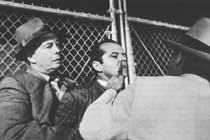
{07399} hesitation wounds
Suffocation, strictly defined, means death from lack of oxygen in the environment.
A looser definition, which also includes smothering as a form of suffocation,
is failure of oxygen to reach the uppermost airway.
 Mechanical asphyxia
Mechanical asphyxia
Conjunctival petechiae
WebPath Photo
 Drunkards, druggies, and the very debilitated can and do die of aspirating chewed food or vomit.
Be careful making this diagnosis, since agonally, perhaps 25% of people get food on
the airway, and there can be reflux when the dead body is moved.
Drunkards, druggies, and the very debilitated can and do die of aspirating chewed food or vomit.
Be careful making this diagnosis, since agonally, perhaps 25% of people get food on
the airway, and there can be reflux when the dead body is moved.

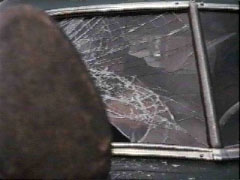
{07056} petechiae in strangulation
{07074} manual strangulation

 Suicidal hanging
Suicidal hanging
Source unknown
Not for young or sensitive visitors.
 Suicidal hanging
Suicidal hanging
Source unknown
Not for young or sensitive visitors.
 Hanging of Jewish civilians
Hanging of Jewish civilians
Romania under Nazi occupation
WWII era
 Autoerotic asphyxia
Autoerotic asphyxia
Source unknown
Not for young or sensitive visitors.
Many a good hanging prevents a bad marriage.
-- Shakespeare, Twelfth Night
 Ligature strangulation: Compression of neck structures is secondary to a noose tightened by
something other than body weight
Ligature strangulation: Compression of neck structures is secondary to a noose tightened by
something other than body weight
{10415} ligature strangulation (belt)
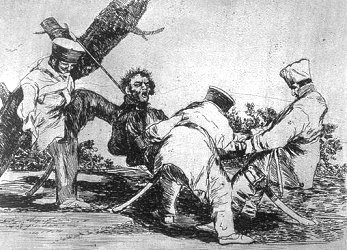


{07137} strangled by hand
 Strangled by hand
Strangled by hand
Ed Lulo's Pathology Gallery
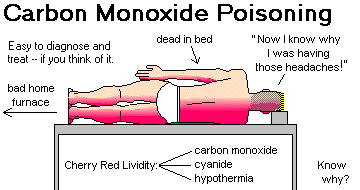
{07116} carbon monoxide after-effects on globus pallidus
 Carbon monoxide
Carbon monoxide
Cherry red
WebPath Photo
{46535} burn
{46536} burn
 Fatal burns, "necklacing"
Fatal burns, "necklacing"
African political punishment
Burning tire is placed around neck
7103} second-degree burn histology
{07184} could be Curling's ulcers
{07147} drowned
{07027} decomposition speeded
by warm water
Effect of current:

Electrical burns are generally small, gray, charred marks with a grayish-white rim (blood was driven
out, then vessels were seared closed). And in the large majority of electrocutions
on household appliances, there is NO lesion found on autopsy.
Death does not occur instantaneously after the shock, and
the victim's last act may be to turn off the defective tool or remove
the contact, making it much harder to recognize that this is an electrocution.
 Struck by lightning
Struck by lightning
Lichtenberg figures
Patient photo from NEJM
 {07190} lightning wound
{07190} lightning wound
{07513} lightning wound
{07037} electrical injury and burn
{07107} electrical trauma
{07109} lightning death
{07504} lightning death
{07183} electrocuted
{07187} electrical injuries
{07480} electrical injuries
{07486} electrical injuries
{07495} electrical injury, where current exited
{11127} electrical injury, where current exited
{07537} lamp-in-the-bathtub homicide
* Dr. Overman, past medical examiner of Jackson County, shared the following anecdote:

 Cold water
Cold water
WebPath Photo
 Gangrene
Gangrene
From frostbite
WebPath Photo
 TORTURE
TORTURE
 * Some countries use corporal punishment for criminal offenders.
Delaware used whipping as an alternative to
incarceration into the 1960's; the skin was almost
never broken, and the purpose was to embarrass the perp
and make it clear that punishment was being delivered
without requiring time behind bars.
Thankfully, we now sentence non-dangerous
offenders to "community service" instead.
* Some countries use corporal punishment for criminal offenders.
Delaware used whipping as an alternative to
incarceration into the 1960's; the skin was almost
never broken, and the purpose was to embarrass the perp
and make it clear that punishment was being delivered
without requiring time behind bars.
Thankfully, we now sentence non-dangerous
offenders to "community service" instead.
 East Timor Human Rights Council Photos
East Timor Human Rights Council Photos
Includes some of the now-famous photos taken by soldiers
and sold (!) to human-rights activists
Not for young or
sensitive viewers
Terms:
Radiation sickness

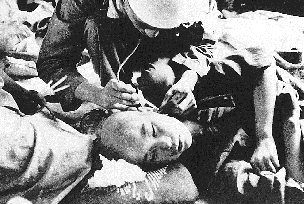 In survivors of Hiroshima and Nagasaki, the following additional health effects were noted:
In survivors of Hiroshima and Nagasaki, the following additional health effects were noted:
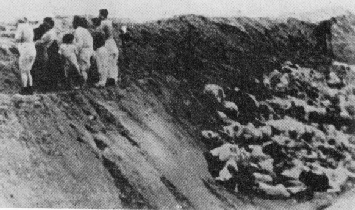
Lead me from death to life, from falsehood to truth.
Lead me from despair to hope, from fear to trust.
Lead me from hate to love, from war to peace.
Let peace fill our heart, our world, our universe.
-- Brihadaranyaka Upanishad (Hindu scripture)
--Anakin Skywalker
Do you love your Creator? Love your fellow-beings first.
-- Mohammed
Lord, make me an instrument of your peace.
Where there is hatred, let me sow love,
where there is injury, pardon,
where there is discord, union,
where there is despair, hope,
where there is doubt, faith,
where there is darkness, light,
where there is sadness, joy.
O divine master, grant that I may not seek so much
to be consoled as to console,
to be understood as to understand,
to be loved as to love.
For it is in giving that we receive,
it is in pardoning that we are pardoned,
and it is in dying that we are born to eternal life.
-- Attributed to "Francis of Assisi" (John Bernardone) c. 1230
|
I am an absolute pacifist. It is an instinctive feeling. It is a feeling that possesses me, because the
murder of men is disgusting.
-- Albert Einstein (Christian Century, 8/28/1929) |

|
The ballot is stronger than the bullet.
--Abraham Lincoln 5/19/1855
I am proud of the fact that I never invented weapons to kill.
--Thomas A. Edison, NYT 6/8/1915
 |
I think that people want peace so much that one of these days governments had better get out of the
way and let them have it.
-- Dwight D. Eisenhower, 8/31/1959 |
Violence usually begins with invasion of someone's personal space, respect, or dignity. Everyone feels entitled to these things, whether or not everyone else agrees.
Despite the attention given to random violence, especially in our slums, in recent decades, most homicides are still committed by someone the victim knows. The larger story of any homicide or suicide seldom shows the finer side of humankind. Your lecturer is no expert on security or crime prevention, but he's had considerable reading and professional experience relating to homicides.
The following suggestions will not make you immune to becoming a homicide victim, but will greatly reduce your risk of dying at the hand of someone you know:
1. Don't bully anyone, physically or verbally.
2. Don't ridicule anyone. (This is a really important survival tip.)
3. Don't try to take another person's wife or girlfriend.
4. Don't crowd or speak rudely to a person who is obviously upset, even if he or she is threatening you or someone else.
5. When a relationship breaks up, be tactful and kind to the person to whom you were important.
6. Don't deal drugs.
7. Don't do sexual things for money or drugs.
8. Men: Don't carry a weapon. (This applies in the vast majority of circumstances. There are exceptions.)
9. Women: Don't be a sexual tease.
10. Gay men: Don't do sexual things with men you don't know well, or with jealous (i.e., nutty, insecure) men. Don't ask out men you don't know well. (Homicides: AJFMP 17: 350, 1997).
11. Children and teens: If the adults you must live with are abusive, pretend you love them anyway.
 Sociobiology in action: Living with a step-parent is the most powerful risk factor for child abuse yet
identified. See Science 261: 987, 1993. A child in Canada is sixty times more likely to be
murdered by a step-parent than by a parent: Sci. Am. 273(4):
174, Oct. 1995.
Readers will not be surprised that in the US, infanticide is far more
common if Mom is less than 17: NEJM 339: 1211, 1998.
Sociobiology in action: Living with a step-parent is the most powerful risk factor for child abuse yet
identified. See Science 261: 987, 1993. A child in Canada is sixty times more likely to be
murdered by a step-parent than by a parent: Sci. Am. 273(4):
174, Oct. 1995.
Readers will not be surprised that in the US, infanticide is far more
common if Mom is less than 17: NEJM 339: 1211, 1998.
*Child-kills-parent: rare. Usually Dad is murdered, usually for being a control freak.
* In the townships of "the new South Africa", a child is almost as likely to be killed in cold blood (often shot to death, something which almost never happens in the U.S.) as he/she is to die in an accident (Am. J. For. Med. Path. 24: 141, 2003).
NOTE: Alcohol is a factor in a majority of homicides. Certain men, under the influence of alcohol, are prone to fire their handguns at other people for no reason. Even when there is some motive, a majority of murderers have alcohol on board at the time of the crime, and a majority of victims have alcohol on board.
NOTE: When there is a motive for murder, other than disputes among drug-culture types, sex is
almost always involved, and usually somebody has insulted
the murderer's pride in this particular
area. The most classic of all non-underworld, non-underclass homicides is the man who kills the
woman who left him.
* NOTE: There are 20,000 violent murders yearly in the US (J. For. Sci. 42: 279, 1997).
"If a man kills one person, he's a criminal. If a man kills 100,000 people, he's a hero."
Whether the violence is individual or institutionalized, violent people will surprise you by their
selective delicacy of conscience. They may be crusaders for good causes and pillars of the local
place of worship, exhibit extreme tenderness toward children, the sick, the elderly, and so forth.
Hitler and Ted Bundy embraced vegetarianism,
because they professed to abhor harming innocent creatures. Hitler was opposed
to using animals for medical research.
* Easy, wrong answers:
If "violence in the movies and on TV" is a major factor in our epidermic of violence
(as suggested in JAMA 267: 3059, 1994), why is the murder rate 10 x lower in Canada, where they
watch the same shoot-'em-ups?
See Psychiatry 56: 3, 1993. And if handguns are the problem, why is the
murder rate similar in non-inner-city Canada (where murderers use knives and bludgeons) and non-inner-city areas our own states
that adjoin Canada (where gun ownership is much higher, and the
murderers use guns; see Am. J. Epidem. 134: 1245, 1991)? More on international comparisons:
JAMA 263: 3292, 1990. In some US elementary and high schools,
most of the students are armed with guns simply for self-protection,
yet there
are surprisingly few shootings, and the kids are far safer
in school then outside. Although there is much less legal gun
ownership in Sweden, there are still plenty of mass-shootings:
AJFMP 19: 34, 1998.
Murder rates per 100000 people per year worldwide: South Africa 75.3 (Am. J. For. Med. Path. 24: 141, 2003),
Philippines 38,
Lesotho 36, Jamaica 18, US 8, France 4, Britain 1.3, Ireland 0.5. Obviously there's something more
than "guns cause murders". More easy explanations that aren't true...
The familiar right-wing claim that more people have died violently
since the 1859 publication of "The Origin of Species",
and the familiar left-wing claim that "science leads to a devaluing
of human life", both
ignore the fact that the world is more densely populated today
thanks to science (public health, fertilizer); nevertheless,
Tamurlane probably killed
as many people as Hitler did in his own era. The familiar right-wing
claim that child abuse is a new phenomenon caused in particular
by the decline in "family values"
ignores the fact that physicians
simply denied, ignored, or covered it up during the "good old days" before the
1960's.
Reading about how we "discovered" why some babies have multiple
fractures of different ages is chilling. Society calls for
radical changes in the wake of
shooting sprees (by loonie day-traders whose neighbors knew something was
badly wrong, by high-school kids who were teased and ridiculed for
years by their "well-adjusted" peers, and so forth). But
at the same time, society goes gah-gah when
honest scientists try to look at the impact of genes or brain chemistry
on bad behavior, or when people talk about putting obviously dangerous,
mentally-ill people in long-term institutional care.
Again, there are no easy answers.
* To compound the mystery... During the early 1990's, the rates for murder,
assault, robbery, and burglary all dropped precipitously in the US.
The causes remain obscure (Sci. Am. 290(2): 82, Feb. 2004).
The epidemic of murder among black and hispanic men ages 14-24
peaked around 1991 (5x above the usual
norms, 1 in 20 ended
up being murdered by a peer in some communities) and is dropping, perhaps because
crack use is being replaced by marijuana use, and marijuana dealers are a non-violent
bunch (uh...?)
Booming economy (timing's off)?
Roe v. Wade causing fewer unwanted neglected children (timing's off)?
More cops (NYC experience)?
Concealed-carry (maybe)? More prisons with the bad people off the streets (uh, this isn't the "politically
correct" answer, but it's the one I find easiest to believe)?
Crime prevention as a public health measure is reviewed in Britain's Lancet 358: 1717, 2001;
it holds America's ugliest statistics up for examination, and points what has worked
and what hasn't; its explanation for the drop in our murder rate is the policy by the
police to focus their attention ("by the book" or not)
on the really bad people and the really bad places. The statistics
(a 1% increase in prison population reduces murder by 1% and violent crime by about 2%)
seem to confirm the common-sense idea that keeping bad people off the streets
is also helpful. Simply increasing the numbers of officers is supposedly less helpful,
and the "zero-tolerance" nonsense (i.e., busting kids for having nailclippers
or an aspirin) does no good.
* You heard it here first. Today's polygraph testing is
a parlor trick, mere salesmanship-and-subscience (NEJM
327: 122, 1992, Lancet 360: 1261, 2002,
and the fact that a bunch of Castro's people all beat
the polygraph to go to work for the CIA some years back,
settled it for me). Not that it really matters, but
the inventor of the polygraph was not a
physiologist but a cartoonist who went on to create
"Wonder Woman".
The Japanese are experimenting with brain wave patterns
which indicate whether a suspect recognizes, or does not recognize, a crime scene. Sounds
interesting. For. Sci. Int. 51: 95, 1991. More generally, your lecturer has fair
confidence
in the criminal justice system's ability to discriminate guilt from innocence, usually,
with the unique
exception of men falsely accused of sex crimes. This is what the inmates themselves told me in the
1980's, and my own experiences and reading bear this out. In today's political climate, an innocent
man must often plea-bargain and even serve prison time (Science 256: 301, 1992; KC Star March
13, 1993; remember also Potiphar's wife Genesis 39:7-20). This has
now become a public
scandal, as has recently happened (1994) with the "false memories"
fiasco of the early 1990's and the ultra-bizarre, no-physical-evidence
child-molestation witch-hunts ("Believe the children!")
of the past 30 years.
In the
meantime, men, you must "love defensively", and you shouldn't even talk much to a woman unless
you know she isn't nuts. Of course, women have always known not to talk
to a man until she knows he isn't nuts, because there is still plenty
of real violence and abuse.
Whether it's abuse of a child or a romantic partner, the behaviors of the
abuser are pretty much stereotyped, and you will come to recognize the
constellation. The common denominator, of course, is that the abuser feels entitled
to love, and has such poor living skills that he or she cannot get it
any other way. Public discussions usually ignore this obvious fact, but
understanding it may help you, the physician, help people make sense out of the
vicious cycle.
The crew at Galveston has finally gotten
up evidence to show that, yes, beating a pregnant woman can give her preterm labor and
chorioamnionitis (Am. J. Ob. Gyn. 170: 1760, 1994).  * NOTE: Criminality has no easy explanation. The classic parents of a criminal (an
alcoholic bully
father, a hysterical pill-popping mother) are folks whom you'll meet soon enough, but many
criminals come from "nice homes", and most brothers of hardened career criminals have no criminal
records themselves. For decades, the social psychologists
have insisted that "violent criminals
suffer from low self-esteem", and based treatments on this ideology.
A review team found that there was never been any empirical evidence that this is true.
Having known a few, I concur strongly with the team that they are mostly big-ego
types who have decided they are special, above the law (Sci. Am. 284(4):
96, 2001).
Other "enlightened" explanations for criminality just don't fit the facts either: Poverty isn't the
explanation, since self-reports of misbehavior correlate very little with class. Most poor folk are
decent, law-abiding people who hate the criminals among whom they must live. Despite much
effort, nobody's been able to demonstrate that police and courts treat blacks and whites differently if
they've done the same bad things. Injustice isn't the explanation, since police, victims, and criminals
all agree about what's right and wrong and what should be done with wrongdoers. A few traits of
career criminals are well-known: (1) they socialized poorly as kids; (2) they were poorly supervised
by their parents; (3) they are sensation-seekers and continually seek new excitement; (4) by any
reasonable definition, they are racists; (5) they drink alcohol; (6) they have never been seriously
interested in serious religion; (7) they suffer less from a bad conscience than do the rest of us. I
would have added (8) they are demanding of everyone except themselves; career criminals are the
worst crybabies. Most criminals learn early to cite past wrongs (personal,
ancestral) to gain sympathy and special privileges.
There's a review in Nature 368, 111, 1994. There's a adoption study that
concluded that childhood misbehavior was mostly caused
by the environment, but found that your number
of adult convictions correlated better with convictions of your biological parents rather than your
adoptive parents (!!; Lancet 345: 466, 1995; has a list of candidate genes).
* NOTE: Criminality has no easy explanation. The classic parents of a criminal (an
alcoholic bully
father, a hysterical pill-popping mother) are folks whom you'll meet soon enough, but many
criminals come from "nice homes", and most brothers of hardened career criminals have no criminal
records themselves. For decades, the social psychologists
have insisted that "violent criminals
suffer from low self-esteem", and based treatments on this ideology.
A review team found that there was never been any empirical evidence that this is true.
Having known a few, I concur strongly with the team that they are mostly big-ego
types who have decided they are special, above the law (Sci. Am. 284(4):
96, 2001).
Other "enlightened" explanations for criminality just don't fit the facts either: Poverty isn't the
explanation, since self-reports of misbehavior correlate very little with class. Most poor folk are
decent, law-abiding people who hate the criminals among whom they must live. Despite much
effort, nobody's been able to demonstrate that police and courts treat blacks and whites differently if
they've done the same bad things. Injustice isn't the explanation, since police, victims, and criminals
all agree about what's right and wrong and what should be done with wrongdoers. A few traits of
career criminals are well-known: (1) they socialized poorly as kids; (2) they were poorly supervised
by their parents; (3) they are sensation-seekers and continually seek new excitement; (4) by any
reasonable definition, they are racists; (5) they drink alcohol; (6) they have never been seriously
interested in serious religion; (7) they suffer less from a bad conscience than do the rest of us. I
would have added (8) they are demanding of everyone except themselves; career criminals are the
worst crybabies. Most criminals learn early to cite past wrongs (personal,
ancestral) to gain sympathy and special privileges.
There's a review in Nature 368, 111, 1994. There's a adoption study that
concluded that childhood misbehavior was mostly caused
by the environment, but found that your number
of adult convictions correlated better with convictions of your biological parents rather than your
adoptive parents (!!; Lancet 345: 466, 1995; has a list of candidate genes).
A man always finds it hard to realize that he may have finally
lost a woman's love, however badly he may have treated
her.
"Sherlock Holmes", The Musgrave Ritual
 * Punch-and-Judy have been
considered funny, but domestic violence isn't.
Wife-beating (and girlfriend-beating, and of course child abuse) continues epidemic despite the fact that it's
receiving much more attention lately (as it should). About 1.5 million women in the US
experience "intimate partner violence" each year (JAMA 288: 589, 2002;
this is still too many though it may be fewer than you've been told).
Around 10% of emergency room visits by adult
women result from their getting beaten in an ongoing man-beating-woman situation (JAMA 1995;
discusses the error in Am. J. Psych. 151: 630, 1994 by militant feminists who claimed the number
was 35%). He is often an alcoholic bully or junkie with scrambled brains, but the stereotype doesn't
always hold. Psychiatrists talk about insecurity as the basis for the habitual wife-bearer's part (gee whiz),
and so forth. A small minority are sociopaths, i.e., charming, personable men who are incapable of
acting from moral principles. In turn, she is often a nagger ("...you Just Don't LISTEN!!!!") who
constantly belittles him. While they were dating, she liked his aggressive, assertive style. Now she's
sorry, but where would she go? Plus, she likes it when he apologizes and makes up each time (even
after she has him arrested). When a man kills a woman, it's likely that this stuff has been going on
beforehand. Both partners usually have lousy overall living skills, though sometimes the woman is
well-educated and/or hard-working and just has poor people-skills.
Because of politics, if she beats him, or both
beat each other, or if he even grabs her arms to keep her from hitting or
scratching him, the system still focuses on him as the problem.
With the new focus on
"keeping the family together to keep Mom off welfare", the problem will get worse. Some of these
people may be educable, for their sake and for the kids'. In the meantime, your first concern as a
physician is the physical safety of the woman and children.
Exactly what to do to help in the long-term is much tougher to know;
getting women to shelters and to advocacy seems to help, nobody really seems to have
anything that helps the men be better husbands / boyfriends,
and there are risks of causing reprisals (JAMA 289: 589 & 601, 2003).
* Punch-and-Judy have been
considered funny, but domestic violence isn't.
Wife-beating (and girlfriend-beating, and of course child abuse) continues epidemic despite the fact that it's
receiving much more attention lately (as it should). About 1.5 million women in the US
experience "intimate partner violence" each year (JAMA 288: 589, 2002;
this is still too many though it may be fewer than you've been told).
Around 10% of emergency room visits by adult
women result from their getting beaten in an ongoing man-beating-woman situation (JAMA 1995;
discusses the error in Am. J. Psych. 151: 630, 1994 by militant feminists who claimed the number
was 35%). He is often an alcoholic bully or junkie with scrambled brains, but the stereotype doesn't
always hold. Psychiatrists talk about insecurity as the basis for the habitual wife-bearer's part (gee whiz),
and so forth. A small minority are sociopaths, i.e., charming, personable men who are incapable of
acting from moral principles. In turn, she is often a nagger ("...you Just Don't LISTEN!!!!") who
constantly belittles him. While they were dating, she liked his aggressive, assertive style. Now she's
sorry, but where would she go? Plus, she likes it when he apologizes and makes up each time (even
after she has him arrested). When a man kills a woman, it's likely that this stuff has been going on
beforehand. Both partners usually have lousy overall living skills, though sometimes the woman is
well-educated and/or hard-working and just has poor people-skills.
Because of politics, if she beats him, or both
beat each other, or if he even grabs her arms to keep her from hitting or
scratching him, the system still focuses on him as the problem.
With the new focus on
"keeping the family together to keep Mom off welfare", the problem will get worse. Some of these
people may be educable, for their sake and for the kids'. In the meantime, your first concern as a
physician is the physical safety of the woman and children.
Exactly what to do to help in the long-term is much tougher to know;
getting women to shelters and to advocacy seems to help, nobody really seems to have
anything that helps the men be better husbands / boyfriends,
and there are risks of causing reprisals (JAMA 289: 589 & 601, 2003).
Here's a list of principal reasons people take their own lives. This pathologist's impression is that this is approximately the sequence from most-common toward least-common. It is not exclusive, but covers the large majority of cases. This list is among the greatest of all monuments to human stupidity and cruelty, typically by those surrounding the ultimate victim (there are exceptions).
|
1. Failed relationship... (any age, either sex) 2. Organic mood disorders... (young and middle-aged adults) 3. Financial disaster... (adult men) 4. Chronic poor health... (teens and adults, either sex; suicide in older folks is very often triggered by impending nursing home placement) 5. Abuse (physical or verbal) by a parent... (older children, teens) 6. Fear of being a homosexual... (teens and up, mostly men; see Am. J. Pub. Health 92: 1338, 2002) 7. Bad body image... (teens, younger adults) 8. Schizophrenia... (teens and adults, either sex) |  |
School failure is probably less common than any of these causes of suicide. Athletic failure is also less common.
NOTE: Alcohol is a contributing factor to the crisis that precipitates the suicide in at least 1/3 of cases, probably more.
NOTE: Illegal drug use will exacerbate any of the above problems.
Reactive depression usually results from being dumped or being trapped; both are more depressing than the death of a loved one (Arch. Gen. Psych. 60: 789, 2003). In "conservative traditional societies", it is commonplace for a teenaged girl to commit suicide after being forcibly "married" to a man she hates (Am. J. For. Med. Path. 24: 214, 2003.)
You can find something better than death everywhere. -- "The Bremen Town Musicians"
|
NOTE: Among physically-healthy young people who attempted suicide, failed, and got appropriate follow-up care, 99% are pleased, one year later, that they failed. For a more recent, pretty-much equally optimistic study from Vanderbilt, see J. Traum. 33: 457, 1992; in addition to the familiar truisms, intervening in crazy family situations seems to be critical. |  |
 Crime Scene
Crime Scene
Online fantasy site
"Current investigations"
| Visitors to www.pathguy.com reset Jan. 30, 2005: |
Ed says, "This world would be a sorry place if
people like me who call ourselves Christians
didn't try to act as good as
other
good people
."
Prayer Request
 Teaching Pathology
Teaching Pathology
PathMax -- Shawn E. Cowper MD's
pathology education links
Ed's Autopsy Page
Notes for Good Lecturers
Small Group Teaching
Socratic
Teaching
Preventing "F"'s
Classroom Control
"I Hate Histology!"
Ed's Physiology Challenge
Pathology Identification
Keys ("Kansas City Field Guide to Pathology")
Ed's Basic Science
Trivia Quiz -- have a chuckle!
Rudolf
Virchow on Pathology Education -- humor
Curriculum Position Paper -- humor
The Pathology Blues
 Ed's Pathology Review for USMLE I
Ed's Pathology Review for USMLE I
 | Pathological Chess |
 |
Taser Video 83.4 MB 7:26 min |